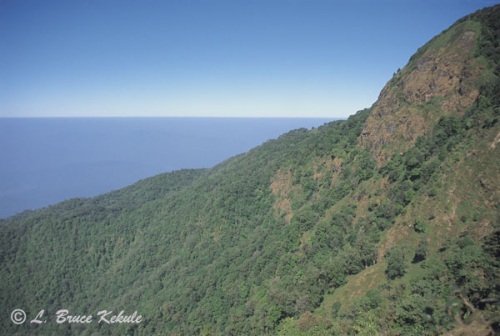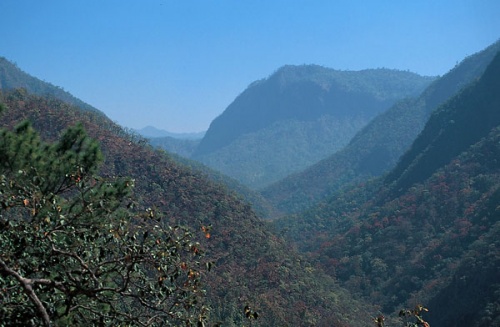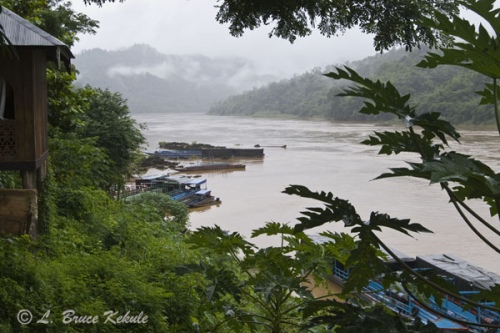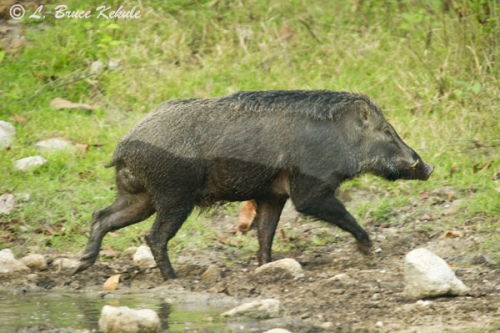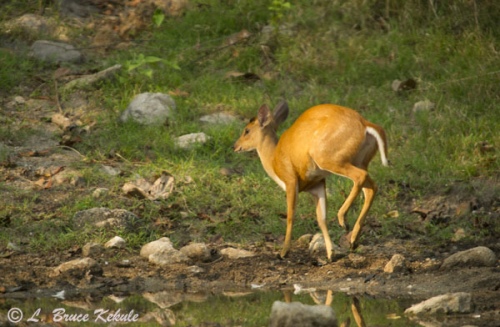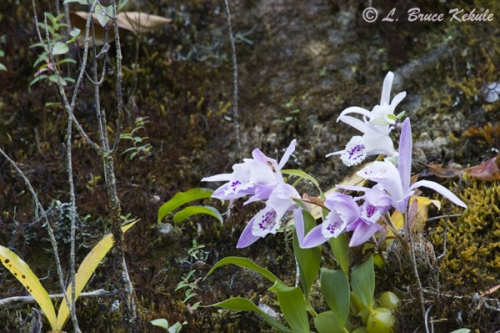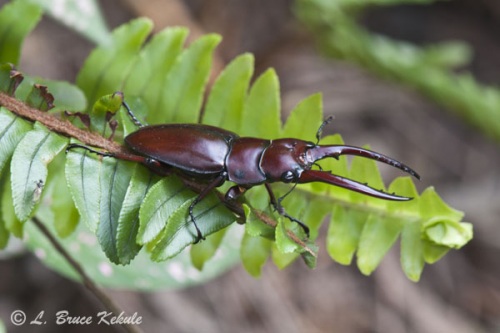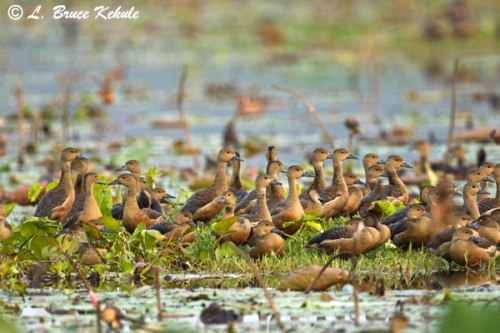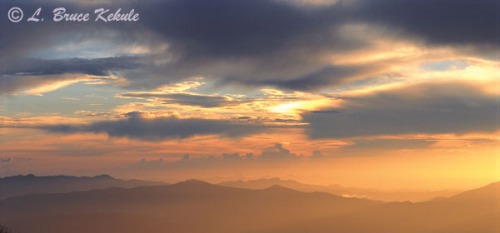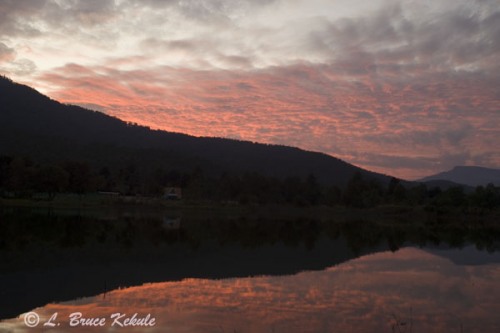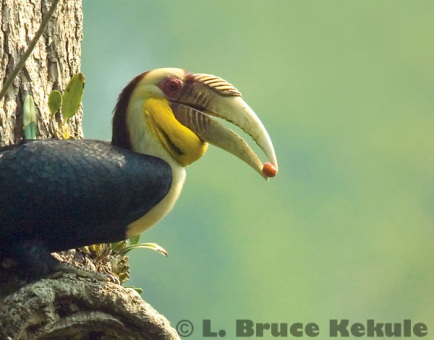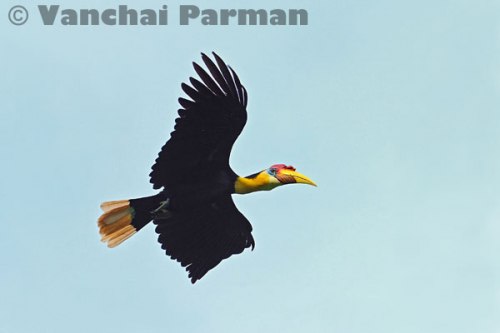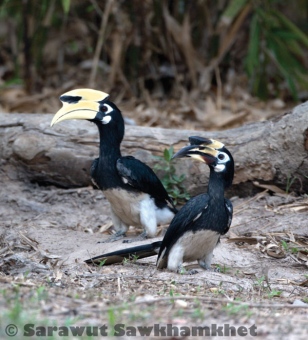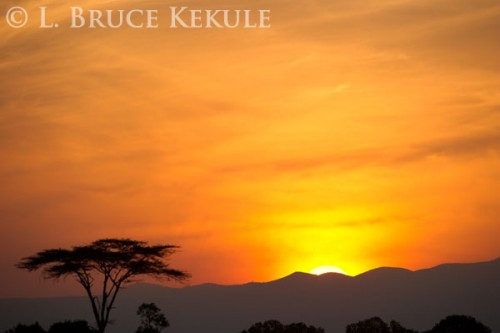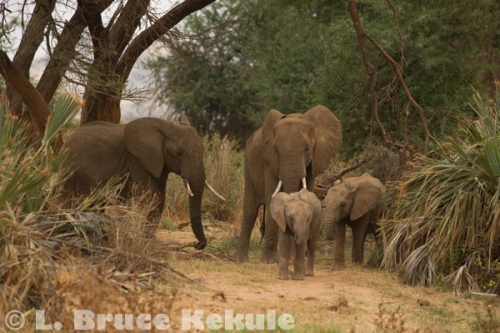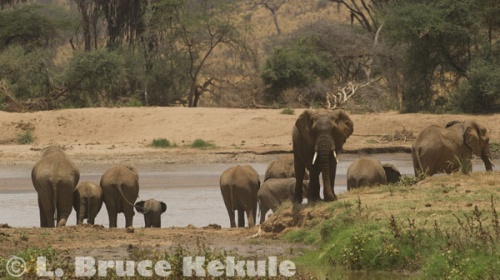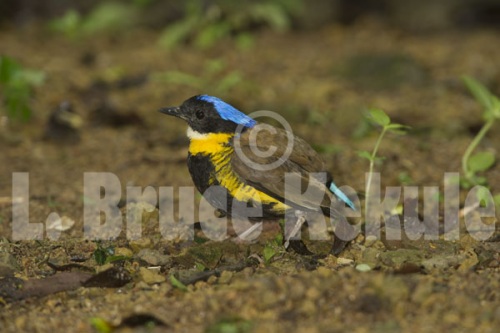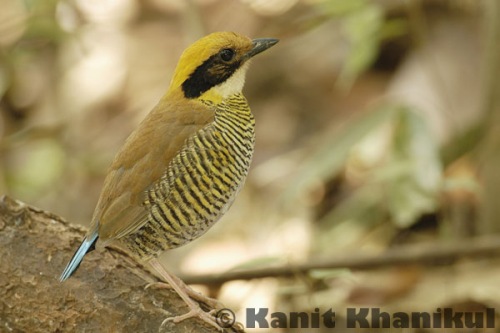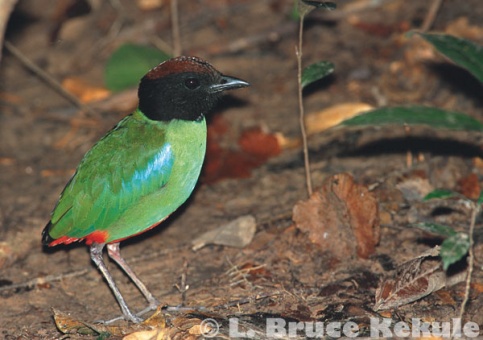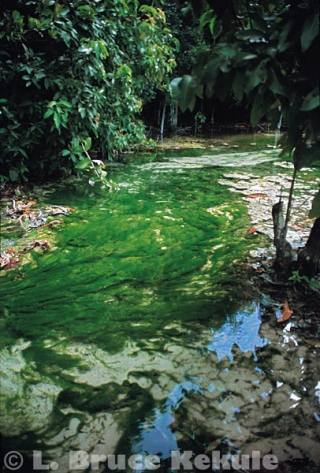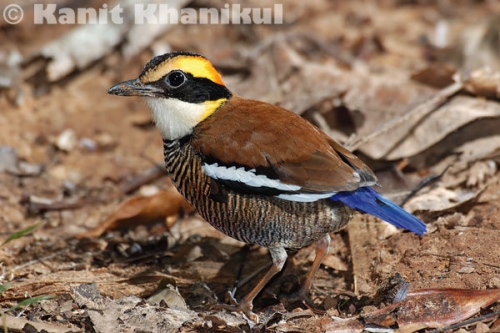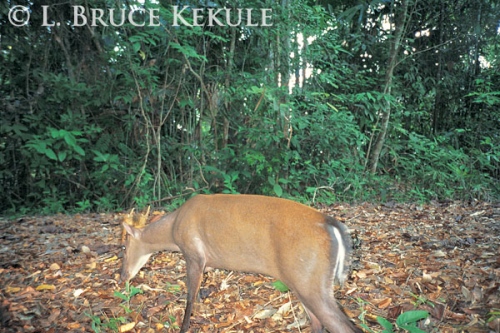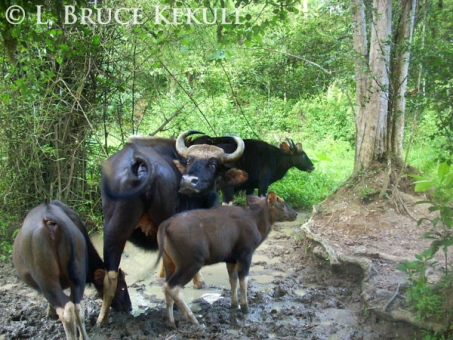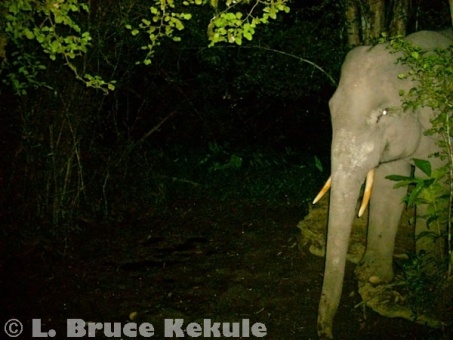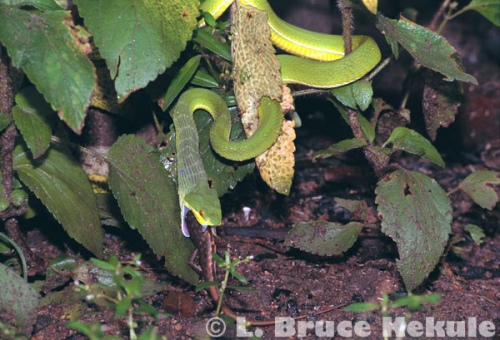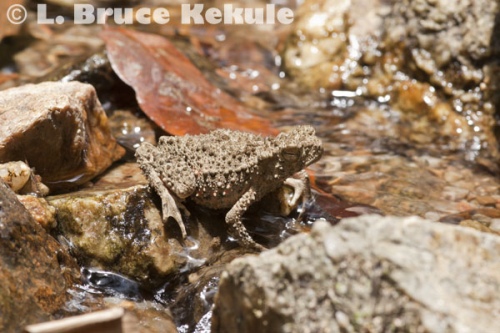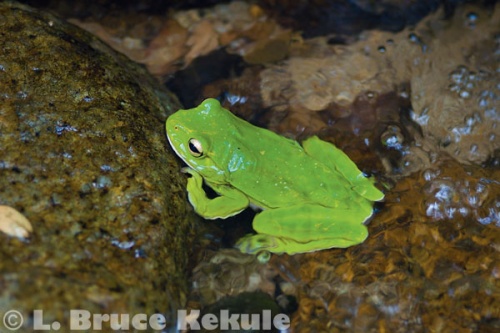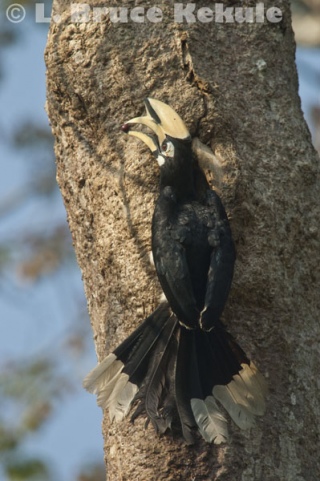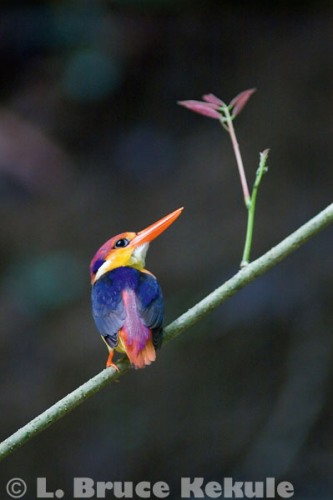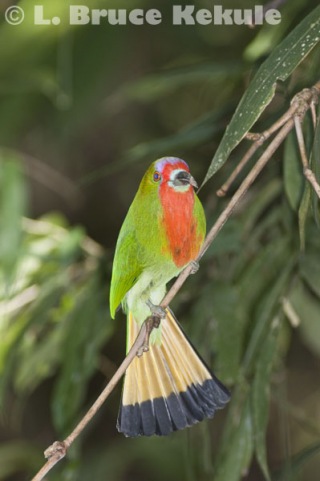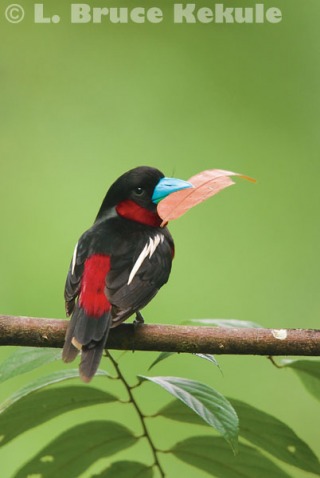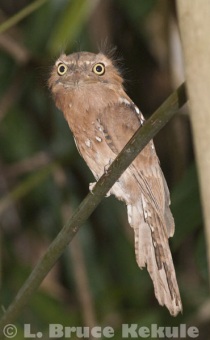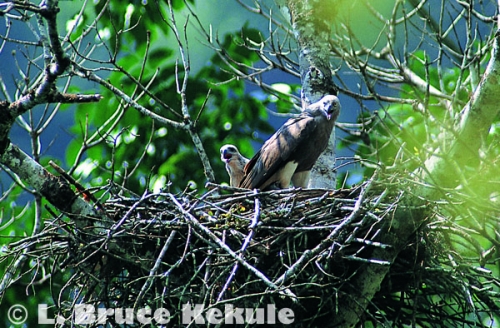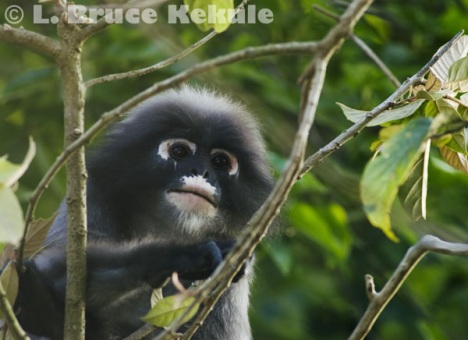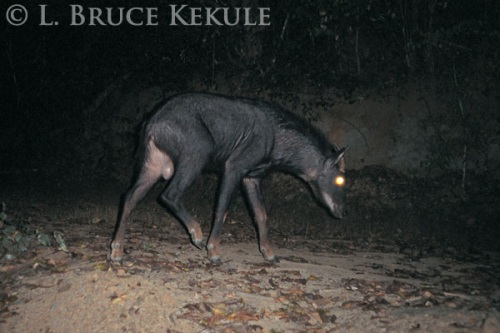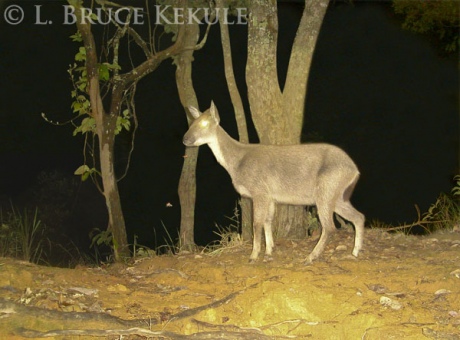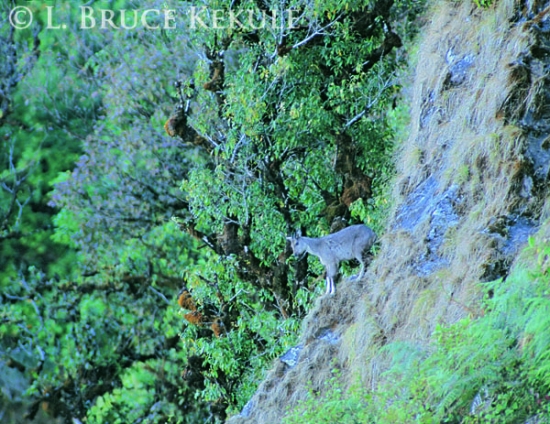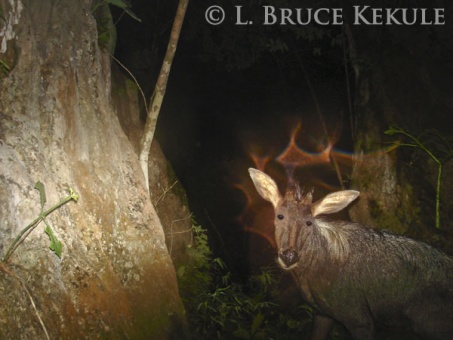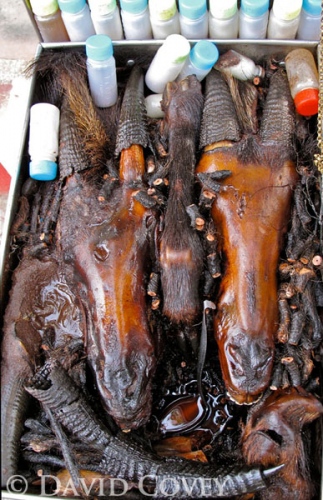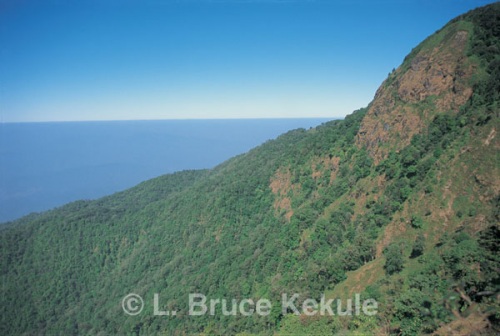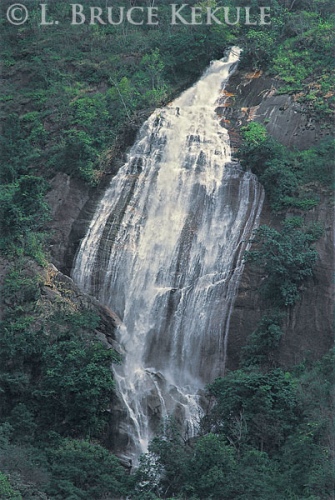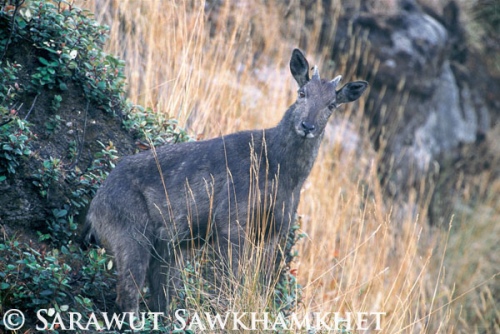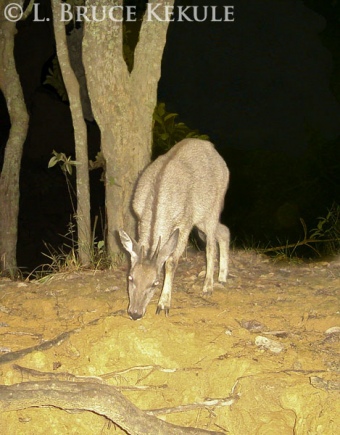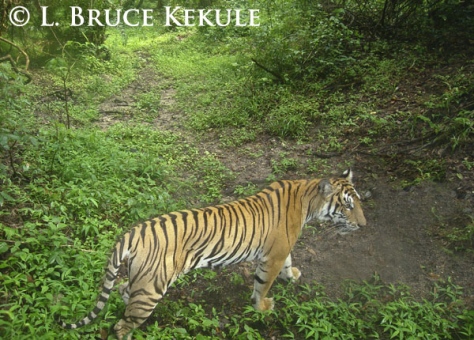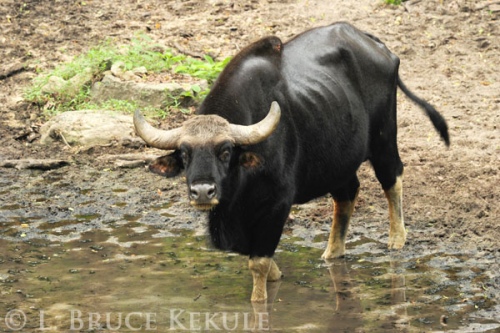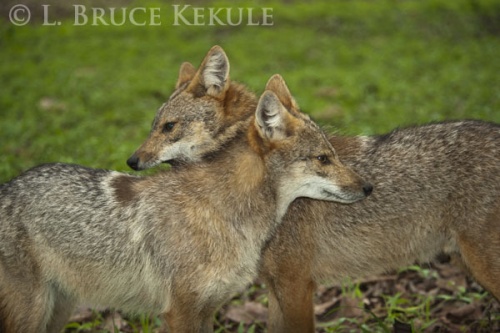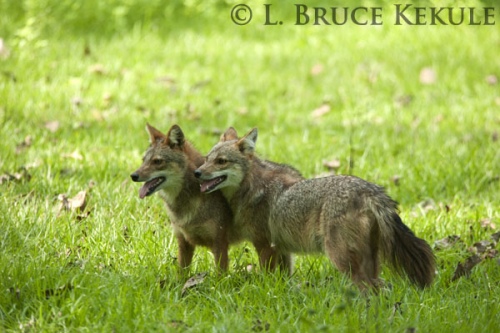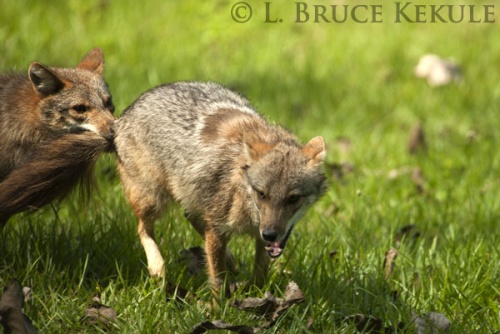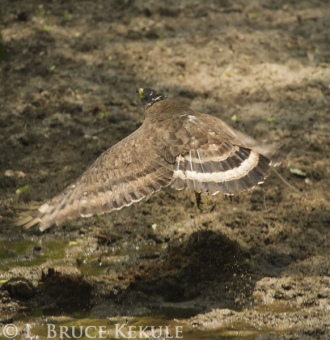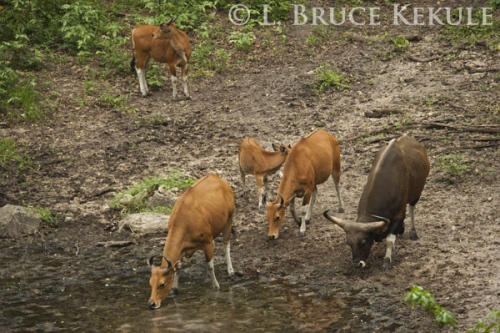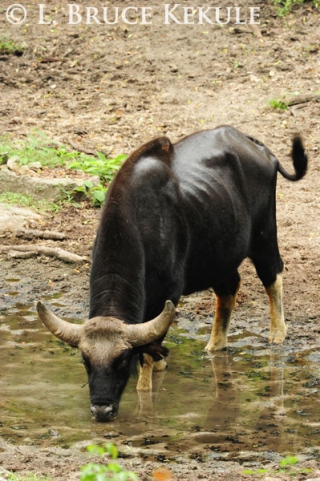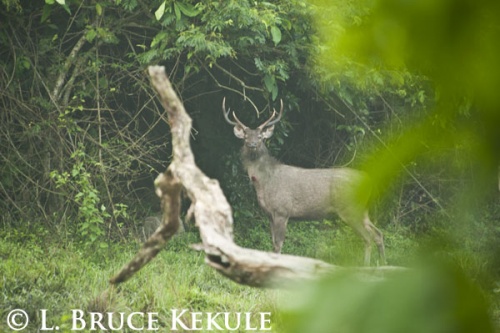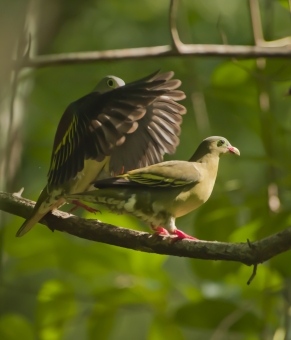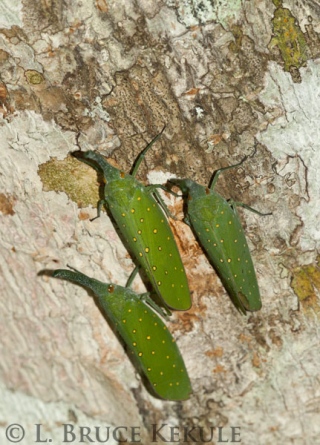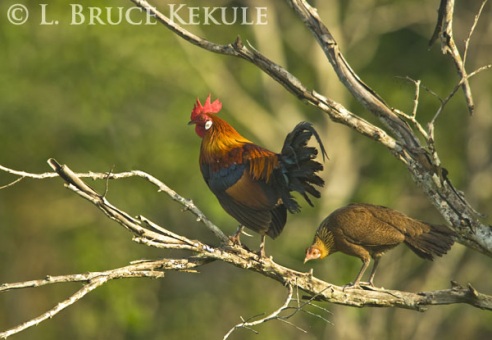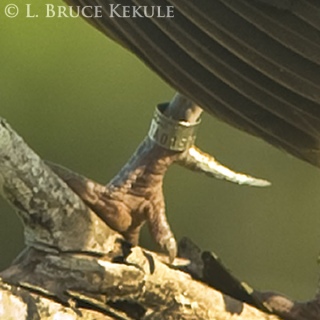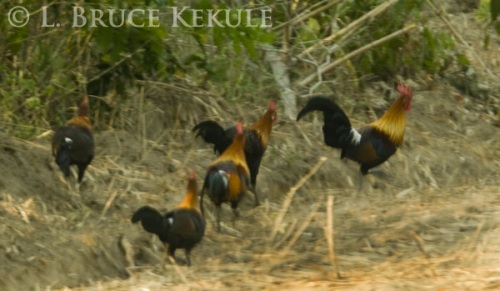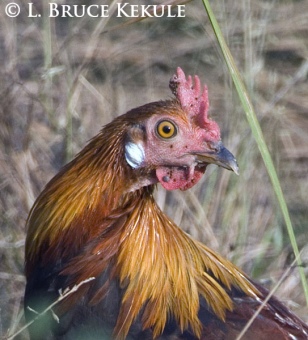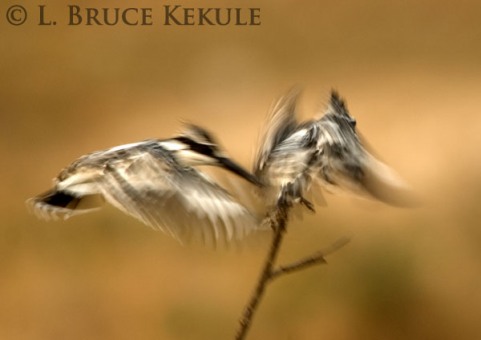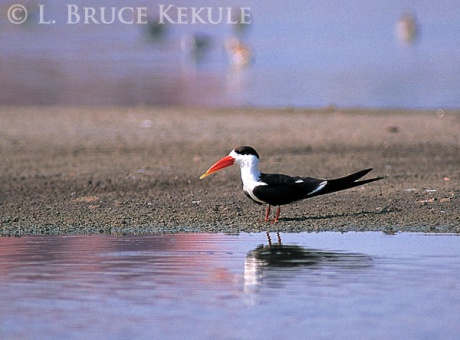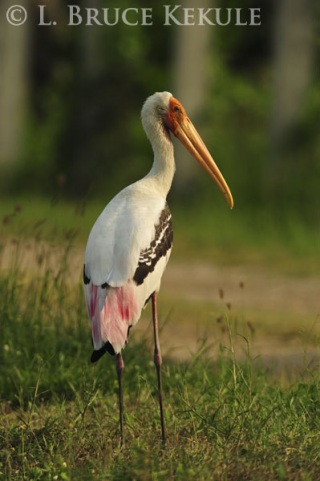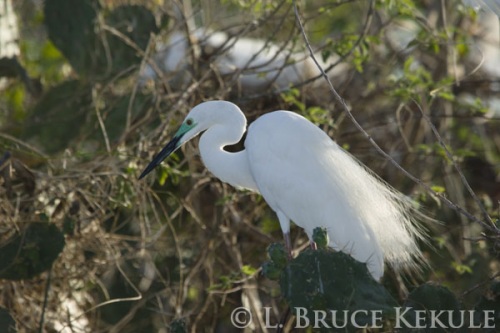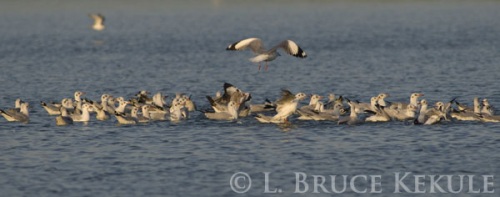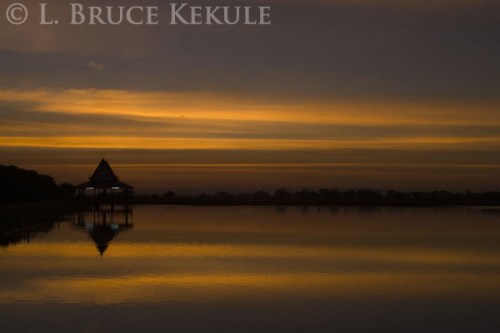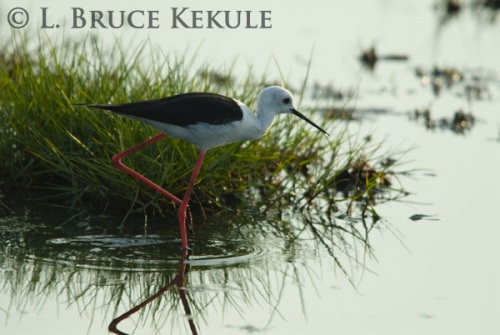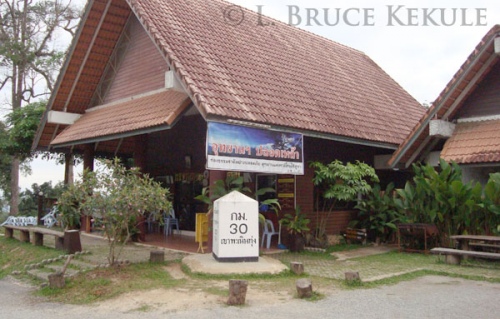WILDLIFE in THAILAND: A Photographic Portfolio of Thailand’s Natural Heritage – Part One
++++++++++++++++++++++++++++++++++++++++++++++++++++++++++++++++
“In my opinion, we should not sit around and argue about the way we use the forest because very little remains“
Seub Nakhasathien
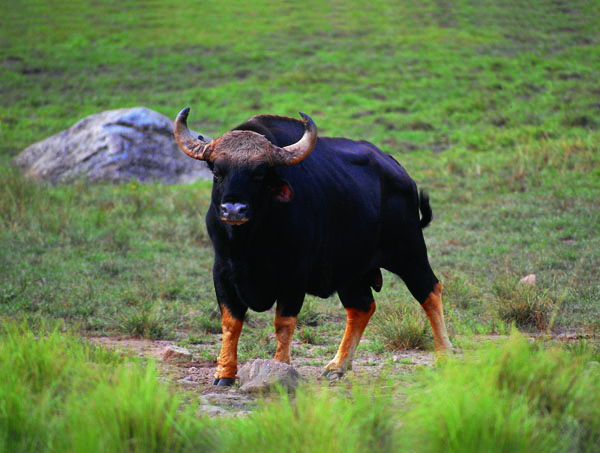
FRONT JACKET
Gaur Bos gaurus in Huai Kha Khaeng Wildlife Sanctuary. This magnificent solitary bull, estimated age about 12 years, has worn his horns down at the tips and damaged the bases by years of fighting with other bulls. Truly in his prime, he has survived danger all his life.

Back Jacket
Leopard Panthera pardus late one afternoon, just before disappearing into the forest. The author, from his vantage point in a photo blind up in a tree, hears langur monkey and barking deer call out as the cat passes by. Very few photographs of black leopard, also known as black panther, have been taken in the wild of Thailand.
Inside Jacket
About this book:
As one millennium passes and another begins, the world has lost much of its rain forests and their inhabitants in the destructive movement of progress. Human population growth, industrialization and man’s quest for money and power are the main culprits.
Recent surveys tell us that an area of tropical forest the size of New York’s Park is being destroyed every ten minutes, the size of New Orleans every month and that of the British Isles every year. Forests are being cut down for timber, livestock ranches, farms, food and housing. Wherever this devastation takes place, it contributes to climatic change through greater greenhouse gas concentrations in the atmosphere. In recent times, severe world weather conditions caused by the El Nino and La Nina phenomena, destructive typhoons, hurricanes, cyclones and their disastrous effects of drought and floods, plus earthquakes have wreaked havoc globally.
We are thus faced with an intractable dilemma. The destruction of our flora and fauna by this and previous generations will have severe consequences in the new millennium, affecting the weather, land and lives of people all over the country and the world.
At the end of the World War II, Thailand’s forests covered an estimated 75-percent of the country. Now, perhaps only 20-percent of forest cover remains, of which half to three-quarters is in protected areas. Many species of plant and animal life have already become extinct to be seen now only in text books, drawings and old photographs.
We are at a crossroads where education and a sense of awareness for all natural living things are the most important tools to save what is left of our forests and wildlife. We also need to communicate through photographic books like this one, and the news media, to those who are uneducated about wildlife so they may understand and see the beauty of the natural world.
Enjoy this photographic trip into the wild of Thailand. Put yourself into each photo as if you were actually there and see the magnificent wildlife that still survives in the Kingdom. This book makes a powerful statement; the photographs speak for themselves.
Wildlife in the Kingdom of Wildlife offers a photographic portfolio of the wildlife in this country, a journey into the realm of the natural world with camera and film to record a small part of what was once a great wilderness.
In order to collect as many images as possible in the four-year period this book allowed, some of the best national parks, wildlife sanctuaries and non-hunting areas were chosen as photographic sites. By learning about each area from continued visits, a considerable knowledge was gained of wildlife habits and habitats. This determined the best times and places for 100 percent photographic success. Wildlife is so wary of humans that it is extremely difficult to see or photograph them in their natural habitat.
Thailand’s flora and fauna are some of the world’s most beautiful. We all need to join together to save what little is left, not only for ourselves but for our children. Taking the inspiration given to us by His Majesty King Bhumibol Adulyadej, Her Majesty Queen Sirikit and the Royal Family, whose proactive concern for the environment continues unabated, may we all play our part in saving and protecting the magnificent wildlife in the Kingdom of Thailand.
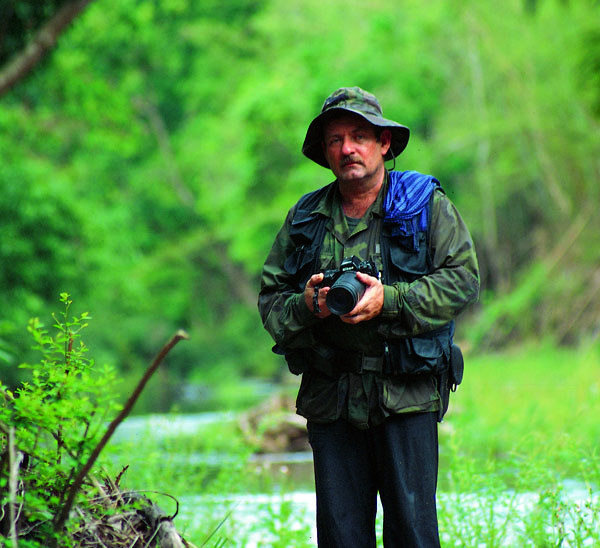
Lawrence Bruce Kekule, an American by birth, has lived in Thailand since 1964. Immediately upon arrival, aged 19, he went up to Chiang Mai to work in his father’s wood handicraft business. His lifelong love of being in the forest continues and, whenever he has the opportunity, ventures into the wild with his cameras. His dream to produce a pictorial book of Thailand’s wildlife began during the mid-1980s after he witnessed extreme changes to the country’s wild areas. Then, in 1995, with his trusty Nikon cameras, he started to visit as many protected conservation areas as possible in search of wildlife subjects to record on film. Wildlife in the Kingdom of Thailand is the fulfillment of his dream.
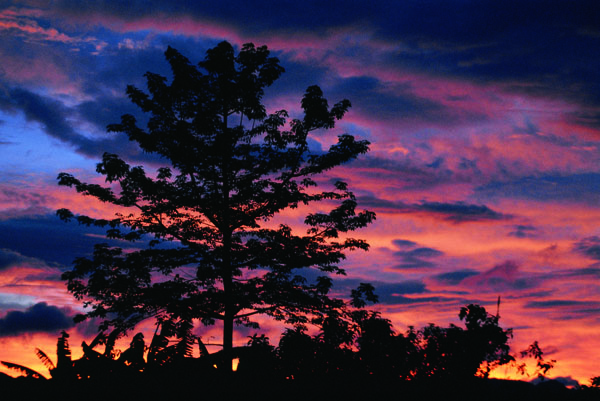
Page 2-3
Sunset in Sai Yok National Park in Western Thailand along the Kwae Noi River. This beautiful protected area has some very rare creatures including tiger, leopard, wild elephant, gaur and many other large and small mammals. The ‘Bridge on the River Kwae’ is not far from here and was made famous during WW II and the Japanese occupation in the 1940s.


Page 4-5
Asian Tapir Tapirus indicus in Huai Kha Khaeng Wildlife Sanctuary.There are many scars on the flank of this otherwise handsome animal (top), probably caused by a predator. Tapir have very thick skin that protects them from attack. Their colouring would seem to stand out, but in fact they are quite well camouflaged. The two-tone colouring breaks up its outline at night and in dark evergreen forests during the day. They are very quick while moving through the brush when escaping from a predator. This very rare mammal, still found in the sanctuary, is nocturnal and rarely seen in daylight. There are very few left here. It is hoped that they will continue to survive in this World Heritage Site.
CREDITS
Page 6
PUBLISHED in 1999 by WKT Publishing Co., Ltd 102/32 Soi Ronnachai
Setsiri Road, Phayathai Bangkok 10400, Thailand Tel: (66-2) 619-6774
Fax: (66-2) 619-6775 e-mail: lbkekule@mac.com
DISTRIBUTED in Thailand by Asia Books Co., Ltd 5 Sukhumvit Road Soi 61
Bangkok 10110, Thailand P.O.Box 40Tel: (66-2) 714-0740-2 ext. 221-223
Fax: (66-2) 381-1621, 391-2277 e-mail: asiabook@ksc.th.com
Photographs and text: Copyright © 1999 L. Bruce Kekule
Map: © 1999 David Unkovich
Editors: Keith Hardy, Tim Sharp
Technical Editors: Dr Sompoad Srikosamatara, Patrick Baker, Lon Grassman Jr.
L. Bruce Kekule would like to thank the companies and organizations whose sponsorship has made this book possible.
Paper Supplied: Advance Agro Public Co., Ltd, Bangkok, Thailand
Printed and bound: Sirivatana Interprint Public Co., Ltd Bangkok, Thailand
Re-Design and Desktop Publishing: L. Bruce Kekule WKT Publishing
Camera Technical Support: George Poole, Waranun Chutchawantipakorn and Sunthorn Teeratamtada
Film Processing: Green House Photo Lab, Bangkok, Thailand
FIRST EDITION – 1999, SECOND PRINTING – 2000, SECOND EDITION – 2001
All rights reserved. No part of this book may be reproduced, stored in a retrieval system or transmitted in any form or by any means, electronic, mechanical,without prior permission of L. Bruce Kekule, WKT Publishing Co., Ltd, Bangkok, Thailand.
For information about reproduction contact WKT Publishing Co., Ltd
Endorsed by the Royal Forest Department
ISBN — 974-87099-8-1
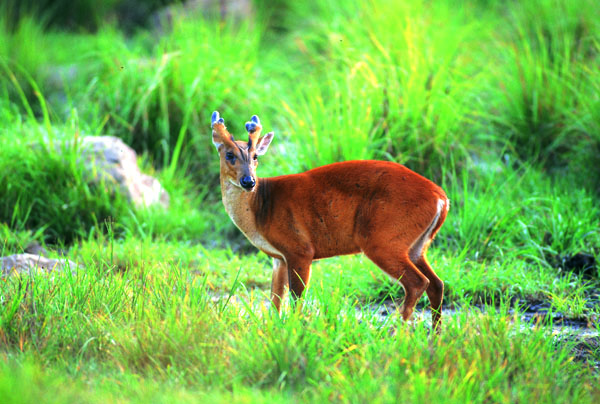
Page 7
Common Barking Deer Muntiacus muntjak in Huai Kha Khaeng Wildlife Sanctuary. This mature male with antlers in velvet, photographed on the same day as the old bull gaur on the front cover, is after a doe in heat. Some other photographs in this book, such as those of banteng, green peafowl and wild dog, were also taken at this remarkable mineral lick.

Page 8
Green Peafowl Pavo muticus at a mineral lick in Huai Kha Khaeng that is also used by elephant, gaur, banteng, barking deer, wild pig, crab-eating mongoose and monitor lizard. Other birds here include the vernal hanging parrot, red-breasted parakeet, thick-billed pigeon and mountain imperial pigeon, changeable hawk-eagle and hornbill.
CONTENTS
Page 9
Foreword – 11
Introduction – 12
Huai Kha Khaeng Wildlife Sanctuary – 18
Thung Yai Naresuan Wildlife Sanctuary – 74
Khao Yai National Park – 100
Kaeng Krachan National Park – 112
Sai Yok National Park – 120
Mountains of the North – 132
Beung Boraphet Non-hunting Area – 142
Wildlife Research – 156
Zoos and captive breeding stations – 162
The Dark Side of Nature – 170
Wildlife photography – 174
Map and List of protected Areas – 176
Acknowledgments – 177
Sponsor Profiles – 178
Bibliography – 180
Photographic index – 181
================================================================

Page 10-11
Huai Kha Khaeng Wildlife Sanctuary during the dry season when the river is at its lowest level. Many species thrive here including tiger, leopard, elephant, wild water buffalo, banteng, gaur and many other large mammals plus smaller creatures. It is the greatest wildlife sanctuary in Thailand.
FOREWORD
Dr Plodprasop Suraswadi – Director General of the Royal Forest Department
Wildlife in the Kingdom of Thailand is a photographic journey into the realm of nature, conveying to the world the magnificent beauty and diversity of Thailand’s natural heritage. Its purpose is to inspire increased conservation awareness in the minds of this generation, in both local and international communities. The extremely difficult but important need to protect and save Thailand’s surviving forests and wildlife is one of the Kingdom’s top priorities. Indeed, His Majesty King Bhumibol Adulyadej, during his continuing reign of more than 50 years, has been and remains at the forefront of many wildlife conservation and reforestation projects around the country.
Wildlife photography is one of the toughest tests of a photographer and this book contains some truly remarkable photographs of rare and endangered wildlife in their natural habitats. There are photographs here of elephant, gaur, banteng, wild water buffalo, tiger, leopard and many other wonderful creatures of nature. Most of these animals are seldom seen let alone photographed. For his outstanding work in putting this book together, both in text and photographs, L. Bruce Kekule is to be commended. The Kingdom will truly benefit from his excellent portrayal of its wildlife.
Over millions of years, the evolution of our flora and fauna has created an abundance that is truly astonishing, and we are all responsible for its continued survival. Enjoy this photographic portfolio of Thailand’s natural world, but never forget this book’s urgent message: Nature’s clock is ticking relentlessly as species after species disappears from the land. Only prompt action can halt this continuing tragedy and we should all work together to fight the man-made perils facing nature. Then, and only then, can we safely say that the children of today and tomorrow will enjoy the Kingdom’s natural heritage far into the new millennium. Finally, we must all learn to love, respect and live in harmonious coexistence with the wonderful world of nature.
INTRODUCTION: Thailand’s Natural Heritage

Page 12
Cycad Cycas pectinata in Thung Yai Naresuan Wildlife Sanctuary. The cycad is considered one of the oldest species of plant in Thailand, having been around since at least the days of the dinosaur some 120 million years ago. The plant at the back has died, hence the golden color of its fronds. Cycad are still common in the sanctuary and along the Tenasserim and Thanon Thongchai mountain ranges.
The Kingdom’s glorious wildlife
About 120 million years ago, one of the most gigantic carnivorous dinosaur the world has ever known, roamed in what is now part of northeast Thailand. Just recently discovered and named, this tyrannosaur Siamotyrannus isanensis, the predecessor of the famed North American Tyrannosaurus rex, adds to the sum total of knowledge that this mystic and majestic land has always been a haven for some extremely interesting and diversified wildlife.
Thailand is one of the wealthiest countries in the world in terms of biodiversity. As just one example, Doi Suthep-Pui National Park, an area of only 261 square kilometers, near the city of Chiang Mai, contains more species of plant than the whole of Europe. The country was once so rich in flora and fauna that a movie named ‘Chang’ (Thai word for elephant) was made in Nan province in the 1920s, using real wildlife and the jungle as props. This movie was recently rediscovered in the West and shown on national television.
Thailand owes its extraordinary natural wealth to its location at the heart of Southeast Asia. With an area of 513,115 square kilometers, it is at the crossroads of several major bioregions and covers almost 15 degrees of latitude in the tropics. These conditions, together with the country’s vast range of land- forms, weather patterns, vegetation types that derive from its geographic location, generate this astonishing natural wealth.
Some idea of this richness can be gained by looking through this book. Tragically, much of what you will see is now seriously endangered. As recently as the beginning of the twentieth century the whole of the country, from the mountains of the north to the coastlines and islands of the south, and from the eastern plateaus across the central plains to the thick jungles of the west, was covered by a lush green carpet of forest that teemed with life. Today, this once vast natural domain is now sadly depleted.
Consider, for instance, the world’s smallest mammal, the Kitti’s hog-nosed bat, named after its discoverer. This bat was found in the 1970s within a few caves along the western border with Myanmar (formally known as Burma) in Sai Yok National Park. Although it still survives, it is endangered throughout its range. The International Union for the Conservation of Nature (IUCN) lists this bat among the most endangered animals in the world.
The Asian elephant is the second largest land mammal on earth, surpassed in size only by its African cousin. Elephant live here in the wild, and in the cities and towns where many of them are abused and exploited for the tourist trade and open-air restaurants. Their numbers in the wild diminish year by year due to habitat loss that basically affects all wildlife. Some are hunted for their ivory but there are very few big tuskers left. Probably no more than 5,000 wild and domesticated elephant remain in Thailand, a sad situation indeed.

Page 13
Bengal Monitor Varanus bengalensis in Thung Yai Naresuan Wildlife Sanctuary. This female lizard is full of eggs, ready to lay. When the author’s presence was detected, she dashed full tilt across the mineral lick. These carnivorous reptiles are still common in Thailand.
Thailand has gaur — the great forest ox and world’s largest bovine. There are also banteng, a slightly smaller species of red cattle, in some areas. Asian wild water buffalo, akin to domesticated buffalo, also exist here but in very small numbers and found only in Huai Kha Khaeng Wildlife Sanctuary. Only one herd remains, comprising less than 50 animals. Other wild herds still exist in India and Nepal. Prior to the long Indochina conflict, Vietnam and Cambodia also had wild water buffalo but their status today is not known. All wild bovine in this region are seriously endangered.
The world’s largest cat, the tiger, is here, albeit critically endangered throughout its range. Other cats include Asian leopard (black and spotted), golden cat, clouded leopard and marbled cat, along with several other smaller species of feline. There are two species of Canidae, Asian wild dog and Asiatic jackal. They are all in serious jeopardy due to poaching of their prey species and habitat loss.
There are five species of deer in Thailand comprising of sambar (the largest), hog deer, brow-antlered (Eld’s) deer, common barking deer and Fea’s barking deer. There are two species of mouse deer (greater and lesser). Hog deer have been reintroduced into Phu Khieo Wildlife Sanctuary and brow-antlered deer were reintroduced into Huai Kha Khaeng and doing well.
Other ungulates (hoofed animals) are tapir, wild pig and two species of goat-antelope, the serow and goral. Goral live in several small pockets in Om Koi and Maelao-Maesae wildlife sanctuaries and a few other areas in the north, where their existence is under threat from poachers. They are therefore extremely endangered. There are a few unconfirmed reports of Sumatran rhinoceros along the western border with Myanmar and southern border with Malaysia. They have not been sighted officially for more than 30 years.
Asiatic black bear and Malaysian sun bear can be found in a few forested areas but are highly endangered by the illegal market for bear paws and bladders. Seven species of civet cat, including the binturong and large Indian civet, as well as many other mammals like badger, weasel, pangolin, porcupine, mongoose, marten, otter, bat, squirrel and other rodents are found here. Primates include slow loris, gibbon, macaque and langur.
Thailand also has a fascinating array of birdlife. Over 1060 species have been recorded (ten per cent of the world’s birds!), with new ones added to the list all the time. During the winter months, thousands of birds migrate to Thailand and some pass through on their way even further south. Unfortunately, many species of flora and fauna have disappeared from the land due to poaching and severe encroachment on their habitat.
Insect species number in the hundreds of thousands. In Huai Kha Khaeng alone, thousands of beetle species have been found in one hectare. Many species continue to be discovered.
A coastline stretching for thousands of kilometers affords an unparalleled marine habitat that includes coastal areas covered with moist evergreen, swamps and mangroves.
Clearly, this book could not hope to record more than a fraction of this wealth. Therefore the author has chosen to concentrate on a select few of the major national parks, wildlife sanctuaries and non-hunting areas. By learning about each area through repeated visits, it has been possible to capture unique moments in the lives of some of this country’s most beautiful wildlife.
It is important to understand just how severely threatened much of this superb wildlife really is. As recently as the turn of the 20th century, and just north of what is now Bangkok, elephant, tiger, deer and other animals roamed. In the 1920s, Bangkok was still a sleepy riverside town with almost no roads. Even in the 1940s, any journey over 100 kilometers from Bangkok meant travelling very slowly along deeply rutted dirt tracks that were passable only in the dry season.
Although serious deforestation began as long as 100 years ago, it was not until Thailand was caught up in the mad rush of modernization after World War II that its flora and fauna came under attack. At that point, modern mechanized transport and weapons started to take their toll.
Two notable species that have become extinct, now to be seen only in textbooks, are the white-eyed river-martin and Schomburgk’s deer. Others like the Javan rhino, brow-antlered deer and water birds like the sarus crane, black-neck stork and giant ibis have also disappeared from Thailand’s wilderness areas. They are just surviving in other Asian countries and some zoos. The kouprey, a species of wild cattle that once roamed a small section near the Phanom Dongrak mountain range along the Thai-Cambodian border has probably become extinct. Last confirmed sightings in Thailand were in 1949. The war in Indochina probably sealed its fate.
One result of this drastic depletion has been that white-rumped and red-headed vulture, which were common, have all but disappeared due to lack of carrion. Poisoned bait meant for tiger was another problem. The vulture would swoop down, feed on the carcass and then perish alongside. In the early 1990s, this was recorded and photographed in Huai Kha Khaeng, a sad sight indeed.

Page 14
Leopard Panthera pardus in Huai Kha Khaeng Wildlife Sanctuary. The area attracts many different species of mammal including elephant, gaur, banteng, tapir, pig, sambar and barking deer. As these are prey species for leopard and tiger, the carnivores often come looking for a meal. Also known as panther, the leopard’s spots are clearly visible in the light of the setting sun. On of my best wildlife photographs ever..!
Certainly there is only one creature to blame and that is the human being. Mankind is primarily responsible for this carnage that continues to this day. Although the process has slowed in some respects and accelerated in others, the consequences continue to devastate the Kingdom year after year.
As one example of the wider consequences, Thailand some years ago experienced devastating floods. These were the direct result of damaged watersheds destroyed by excessive logging with no forethought for reforestation when trees were cut. And although some reforestation is now being undertaken, it is already too late for many areas that have been damaged beyond repair. The suffering by the Thai people as a result of these floods has been appalling.
The bright spot in all this doom and gloom is that much of Thailand’s diverse wildlife can still be found in more than 250 protected areas. Altogether, some 14 per cent of the Kingdom’s land area is now reserved, and although most of the protected areas have severe problems, fresh areas are being set aside all the time. Vigorous attempts are now being made to improve park management.
Two pioneers of this dramatic growth deserve to be remembered. Back in the 1950s, one man’s love for this country’s superb forests turned the late Dr. Boonsong Lekagul from a hunter into Thailand’s foremost conservationist. He was also the country’s leading expert at the time on wildlife. He wrote several books, including ‘Mammals of Thailand’ and ‘Guide to the Birds of Thailand’ that are still used today by students of biology. He founded the Association for the Conservation of Wildlife and successfully lobbied for the passage of the first wildlife and national parks legislation.
The other man who richly deserves a place in the roll of honor of Thai conservation is the late Seub Nakhasathien. He was co-author of the nomination by UNESCO of Huai Kha Khaeng Wildlife Sanctuary and Thung Yai Naresuan next door as a World Heritage Site. His untimely death shook the country and put these two protected areas on the map as a place to save at all costs and be admired by everyone.
Thailand’s present system of protected areas consists of some 89 national parks, 47 wildlife sanctuaries and 53 non-hunting areas. Among the national parks, the first to be gazetted (in 1962), and one of the most visited conservation areas in the country, is the 2,168 square kilometer Khao Yai National Park in the province of Nakhon Ratchasima (Korat), near the most westerly part of the Phanom Dongrak mountain range. Bordering it to the east is Thailand’s second largest national park, Thap Lan, at 2,239 square kilometers. The 845 square kilometer Pang Sida National Park lies to the south within the former range of the kouprey. Further east along the border with Kampuchea in Si Sa Ket province there is Khao Phanom Dongrak Wildlife Sanctuary (316 square kilometers) and in Ubon Ratchathani province, Yot Dom Wildlife Sanctuary (225 square kilometers) and Kaeng Tana National Park (80 square kilometers).

Page 16
Kreung Krai, at the mouth of the Huai Kha Khaeng (huai meaning stream), is home to Asian wild water buffalo. Due to the close proximity to the Sri Nakharin dam and reservoir, they are extremely endangered. Barely 50 creatures survive, if that. This gateway to the sanctuary can be penetrated quite easily. This needs serious attention if the area’s wildlife is to survive.
Two pioneers of this dramatic growth deserve to be remembered. Back in the 1950s, one man’s love for this country’s superb forests turned the late Dr. Boonsong Lekagul from a hunter into one of Thailand’s foremost conservationist. He was also the country’s leading expert at the time on wildlife. He wrote several books, including ‘Mammals of Thailand’ and ‘Guide to the Birds of Thailand’ that are still used today by students of biology. He founded the Association for the Conservation of Wildlife and successfully lobbied for the passage of the first wildlife and national parks legislation.
The other man who richly deserves a place in the roll of honor of Thai conservation is the late Seub Nakhasathien. He was co-author of the nomination by UNESCO of Huai Kha Khaeng Wildlife Sanctuary and Thung Yai Naresuan next door as a combined World Heritage Site. His untimely death shook the country and put these two protected areas on the map as a place to save at all costs and to be admired by everyone.
Thailand’s present system of protected areas consists of some 89 national parks, 47 wildlife sanctuaries and 53 non-hunting areas. Among the national parks, the first to be gazetted (in 1962), and one of the most visited conservation areas in the country, is the 2,168 square kilometer Khao Yai National Park in the province of Nakhon Ratchasima (Korat), near the most westerly part of the Phanom Dongrak mountain range. Bordering it to the east is Thailand’s second largest national park, Thap Lan, at 2,239 square kilometers. The 845 square kilometer Pang Sida National Park lies to the south within the former range of the kouprey. Further east along the border with Kampuchea in Si Sa Ket province there is Khao Phanom Dongrak Wildlife Sanctuary (316 square kilometers) and in Ubon Ratchathani province, Yot Dom Wildlife Sanctuary (225 square kilometers) and Kaeng Tana National Park (80 square kilometers).
Thailand’s southeast encompasses a system of mountain parks and sanctuaries that also borders Cambodia and whose mountains are known in Thai as khao. These begin with Khao Ang Ru Nai Wildlife Sanctuary (1,030 square kilometers) and Khao Chamao-Khao Wong National Park (83 square kilometers). They are situated in the smallest section of the Kingdom along with Khao Soi Dao (745 square kilometers). At 1,670 meters, this is the highest peak in the area and a wildlife sanctuary. It is linked to Khao Khitchakut National Park (59 square kilometers), whose peak at 1,633 meters, together with Khao Soi Dao, forms a saddle. This system also incorporates Khao Khieo Wildlife Sanctuary (144 square kilometers) in Chonburi province and an open zoo. All the mountains are vital to the region as a watershed, delivering water to lowland farmers. This pattern holds true all over Thailand and the importance of the reserved areas cannot be overstressed. The region receives as much as 3,000-4,000 millimeters of rain a year — more than anywhere else in mainland Thailand.
Shortly after Khao Yai was established, Salak Phra Wildlife Sanctuary was gazetted (1966) in Kanchanaburi province as Thailand’s first protected area set up specifically for biodiversity conservation and wildlife research. Of Thailand’s wildlife sanctuaries, the most important are Huai Kha Khaeng (2,780 square kilometers) and Thung Yai Naresuan (3,622 square kilometers), both World Heritage Sites. Jointly, they form one of mainland Southeast Asia’s largest nature reserves. The diversity of their flora and fauna is unrivalled. Split into two administrative sections (east and west), Thung Yai is the single largest protected area in the Kingdom. Salak Phra, Thung Yai and Huai Kha Khaeng are part of the Western Forest Complex which also includes Umphang Wildlife Sanctuary to the north, Khlong Wang Chao, Khlong Lan and Mae Wong National Parks to the northeast, Sri Nakharin, Chalerm Rattanakosin (known as Tham Than Lot), Erawan and Sai Yok National Parks to the south, and Khao Laem National Park to the southwest. The total protected area in Thailand’s largest forest complex is more than 15,000 square kilometers.
Further south, in Phetchaburi province, Kaeng Krachan sits along the border with Myanmar and is, at 2,915 square kilometers, the country’s largest national park. Down the coast in Prachuab Khiri Khan province, Kui Buri National Park where wild elephant and gaur have the largest herds in Thailand. Khao Sam Roi Yot (meaning mountain of three hundred peaks) National Park contains some of the best shoreline habitat in the Kingdom. This small 98 square kilometer park is the breeding ground and wintering home for many species of water and shore birds.
Thailand’s peninsular coastline of some 1,000 kilometers on both the Andaman Sea and Gulf of Thailand contains many national parks, wildlife sanctuaries and non-hunting areas. Several of these are marine zones or offshore islands designated as protected areas. In Krabi, Phuket and Phangnga provinces, the most notable of several reserves is the newly gazetted Khao Phra Bang Khram Wildlife Sanctuary (183 square kilometers) that is home to Gurney’s Pitta, one of the world’s rarest birds. With less than 25 pairs, this bird is highly endangered. Phangnga Bay, where the famous “James Bond Island” is located, is in fact the southernmost tip of the Tenasserim mountain range that stretches all the way from an area in Myanmar next to Tak province in the north of Thailand. Thaleban National Park (102 square kilometers), and Ton Nga Chang and Khao Banthad Wildlife Sanctuaries can be found in this extreme southern part of Thailand.
However, perhaps the most important reserved area in the south is Hala-Bala Wildlife Sanctuary (433 square kilometers) in Yala and Narathiwat provinces. On the southern border with Malaysia, this area is reported to contain Sumatran rhinoceros, elephant, gaur and many other large mammals like tiger, clouded leopard, black panther and bear. But the rarest, most wonderful residents of all are the Sakai nomad hunter-gatherers who live within the sanctuary. They are rarely seen and not much is known of their numbers or habits. On the western side of the peninsula, in Satun province, the Sakai have unfortunately been introduced to modern ways and in this area have lost their natural heritage as true forest dwellers. Adjacent to Hala-Bala Wildlife Sanctuary, Queen Sirikit Reserved Forest, with a total area of 1,337 square kilometers, was recently established.
Further north, on the gulf coast in Songkhla and Phatthalung provinces, three linked lakes or lagoons have been gazetted as non-hunting areas. These extend for 80 kilometers along the coast and cover an area of some 1,500 square kilometers. The furthest lake inland is the Thale Noi which has fresh water. Thale Luang and Thale Sap Songkhla are brackish. The most shoreward lake, Thale Sap Songkhla is protected by a sea wall. Large concentrations of shore and water birds can be found on all three lakes.
Another conservation area, in Ranong, Surat Thani and Phangnga provinces, contains Khao Sok, Sri Phangnga and Kaeng Krung National Parks along with Khlong Nakha, Khlong Saeng and Khlong Yan Wildlife Sanctuaries. Their total area is 3,690 square kilometers. Khao Sok is one of the most visited parks in the country.
Probably the most important non-hunting area is Beung Boraphet in the central plains near Nakhon Sawan, the gateway to the northern region of Thailand. At 212 square kilometers, this is Thailand’s largest freshwater lake and is its most important wetland for resident, migrant and winter visiting birds. This magnificent bird sanctuary is experiencing severe problems with overcrowding by people and excessive fishing activities, both of which are detrimental to the balance between the natural environment and the bird population. There are many other smaller marshes and water bodies in the Kingdom but most of these have been encroached upon by rice, vegetable and duck farming, roads, housing and industrial estates. The status of resident and migrant water birds is critical to say the least!
A small system of parks exists in the eastern part of the northeast, adjoining Laos. They include Phu Phan National Park (664 square kilometers), Huai Huad National Park (828 square kilometers) and Phu Si Tan Wildlife Sanctuary (250 square kilometers) in Sakon Nakhon, Kalasin and Mukdahan provinces respectively. They straddle the Phu Phan mountain range.
Doi Inthanon National Park (482 square kilometers) in Chiang Mai province contains, at 2,595 meters, Thailand’s highest mountain (doi, as well as khao and phu, meaning mountain). Other protected areas in the north include Doi Suthep-Pui National Park (261 square kilometers), and Doi Chiang Dao Wildlife Sanctuary (521 square kilometers), both in Chiang Mai province, Doi Khun Tan National Park (255 square kilometers) in Lampang and Doi Luang National Park in Chiang Rai (1,170 square kilometers).
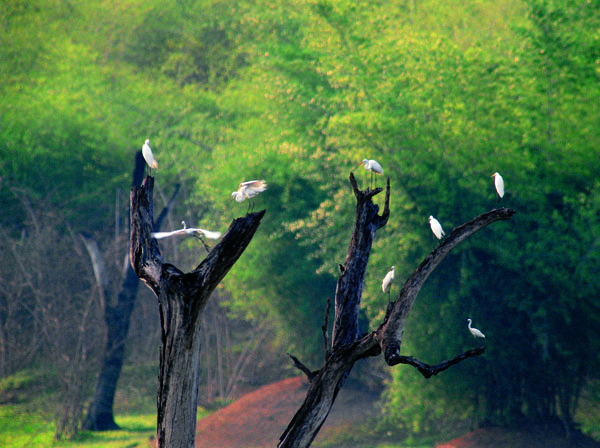
Page 17
Great Egret Egretta alba near the mouth of the Huai Kha Khaeng. There are quite a few around the area and they can be seen here quite easily. These large birds survive on many types of food but fish and insects are their main diet.
In the western area of Esarn, the Thai name for the northeast, within the Dong Phaya Yen and Phetchabun mountain ranges, there is some spectacular scenery, including beautiful forests, and a large system of parks and sanctuaries. The most famous are Thung Salaeng Luang, Phu Hin Rong Kla, Nam Nao and Phu Kradeung National Parks plus Phu Luang and Phu Khieo Wildlife Sanctuaries. These together cover some 5,339 square kilometers. Several smaller parks are interspersed between them. Phu Luang Wildlife Sanctuary is extremely important as it has some fascinating well preserved footprints of the carnivorous Allosaurus dinosaur that roamed here. Phu Luang is also one of Asia’s most crucial sanctuaries for orchids. It harbors some 160 different species.
The largest single reserved area in the north consists of the Om Koi and Mae Tuen Wildlife Sanctuaries with, to the east across the Ping river and Bhumibol dam and reservoir, Mae Ping National Park. They constitute some 3,400 square kilometers of protected area and are situated in Chiang Mai, Tak and Lamphun provinces. These are the last areas in the north that support a few herds of banteng, gaur and goral, the goat-antelope which lives in the lofty crags of Doi Montjong.
Mae Hong Son province in the extreme northwest contains the important Salawin Wildlife Sanctuary (875 square kilometers) and, adjacent to it, Salawin National Park (722 square kilometers). In the same province are Lum Nam Pai Wildlife Sanctuary (1,181 square kilometers) and Nam Tok Mae Surin National Park (396 square kilometers). A new 1,252 square kilometer national park that adjoins Myanmar has been established in Chiang Mai province at Huai Nam Dang. Lampang province contains Namtok Chae Son National Park (592 square kilometers), while Mae Yom National Park (454 square kilometers) in Lampang and Phrae provinces supports the largest natural teak forest in Thailand, the remainder having being decimated by overlogging. Of note is the fact that the Mae Yom River is the only one in the north that has not been dammed.
There are many other smaller areas not mentioned here but the total area of national parks, wildlife sanctuaries and non-hunting areas around the country is about 70,000 square kilometers. Most of them, sadly, are being or have been encroached upon at one time or another by members of society at all levels. Thailand’s future as a nation that cares about the natural world depends on many factors. Hanging in nature’s fine balance, only time will tell whether this country’s superb natural heritage will continue to survive. The Royal Forest Department has a tremendous load on its shoulders to save and protect the Kingdom’s remaining forests and wildlife. It is hope they will succeed in this extremely difficult task.
CHAPTER ONE
HUAI KHA KHAENG WILDLIFE
SANCTUARY:
A magnificent World Heritage Site

Page 18
Sambar C. unicolor down at the river one afternoon for a refreshing drink. Wild water buffalo have just been here, so the mother is very alert, watching for any predator that might be lurking nearby. The young buck’s antlers are in velvet. The other sambar, a very young doe, then watches its mother drink. These deer then play in the river for a few moments before disappearing into the forest. They still survive in good numbers throughout the sanctuary.
Thailand’s most famous wildlife sanctuary, and World Heritage Site, is nestled in the eastern foothills of the Thanon Thongchai Range. Huai Kha Khaeng is a 2,780 square kilometer (1,073 square mile) area located in the central province of Uthai Thani and lies adjacent to Thung Yai Naresuan Wildlife Sanctuary, another World Heritage Site. To the north of Huai Kha Khaeng is Mae Wong National Park and Umphang Wildlife Sanctuary. These are all part of one of the largest conservation areas in mainland Southeast Asia.
Wildlife sanctuaries differ from national parks in that they are not open to the general public and have been set aside for research and biodiversity conservation. Huai Kha Khaeng was gazetted a wildlife sanctuary in 1972 and became a UNESCO World Heritage Site in 1991. This status was achieved through the efforts of several people, the most notable being that of the late Seub Nakhasathien who at that time worked for the Wildlife Conservation Division of the Royal Forest Department. He took his life in the cause of nature and conservation after fighting a losing battle against poachers and encroachment. The impact of his untimely death in September 1990 really shook the country and the area has now become a place to admire and save at all costs.
At the sanctuary headquarters, a museum has been dedicated to the memory of Seub and portrays his work and dedication to conservation. In the surrounding area, one can enjoy wildlife in its natural habitat. Sambar, barking deer, civet cat, porcupine and rabbit can be seen during the night and occasionally during the day. There are 355 species of forest bird in Huai Kha Khaeng and the sanctuary is truly a bird-watchers paradise. As an example, 22 of 36 species of woodpecker found in Thailand are reported in the sanctuary.
The interior is where the sanctuary really lives up to its name as a World Heritage Site. This is where Huai Kha Khaeng’s biodiversity is truly unsurpassed. The diversity of flora and fauna is something that one has to see to believe and understand. The sights and sounds of peafowl in the morning and evening, the doglike call of barking deer evading a predator and the dawn chorus of gibbon, along with hundreds of songbirds, are a true wonder of nature. Huai Kha Khaeng has mixed deciduous forests that still harbour many rare species like tiger, gaur, banteng, wild water buffalo and elephant. Of Thailand’s 297 mammal species, 67 are recorded here. The sanctuary is one of the last wild riverine habitat ecosystems left in Thailand.
Despite this beauty and richness, the wildlife is being poached at an alarming rate by indiscriminate hunting. Poachers slip into the sanctuary, hunting large mammals such as elephant, gaur, banteng and sambar for their trophies and skins. These end up in homes and business establishments as wall trophies and ornaments. The tiger is hunted for its bones and pelt, the bear for its gall bladder and the serow for its head that is supplied to the Asian medicine trade. Some animals are also taken alive for sale in wildlife markets.
The market for wild meat, supplied to some restaurants offering wildlife on the menu, such as deer, wild pig and bear paw, to mention just a few, is another major problem for Thailand’s fauna. Smaller animals like civet, porcupine and monkey, plus many others, are also menu items in these restaurants. It is without doubt that this onslaught to supply the black market has pushed many species to the brink of extinction, a situation that needs serious attention.
Huai Kha Khaeng also has serious problems with forest fires every year. They are usually started outside the sanctuary by unscrupulous people to open up the forests so that poaching and movement is made easier. These people once lived off the land deep in these forests and were evicted by the Government when Huai Kha Khaeng was gazetted.
However, brush fires are thought to help regenerate new grass and feeding grounds for large herbivores, thus the benefits of fire should also be recognized. These fires should be controlled at an early stage after being detected to prevent serious damage to the evergreen forests that can be permanently damaged.
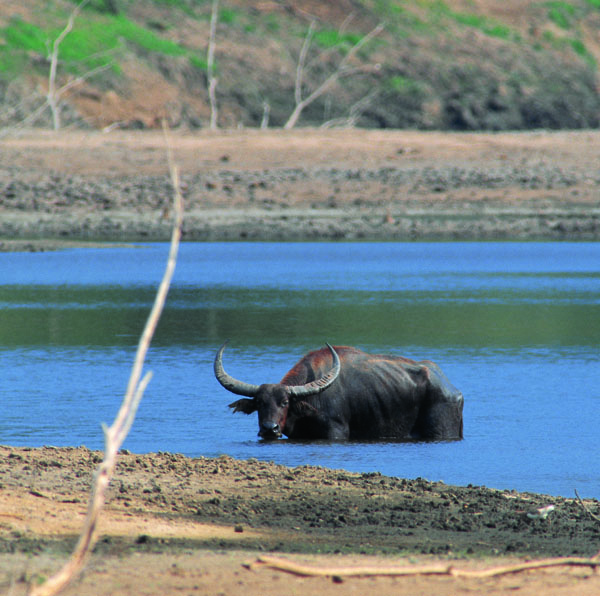
Page 19
Wild Water Buffalo Bubalus bubalis. This old cow’s horns are huge and estimated at some two meters around the curves. Her dorsal ridge is very prominent. Sadly, she limps in and out of the water, probably due to an old wound. She stays in for an hour after the herd leaves, just chewing her cud and enjoying the coolness of the river. With less than 50 individuals remaining, they are extremely endangered.
There are many mineral licks in the sanctuary that are visited by elephant, gaur, banteng, sambar, barking deer, Asian tapir and wild pig. These animals take in trace elements as a natural and important part of their diet. Occasionally, a glimpse of tiger, leopard and Asian wild dog preying on large mammals is possible. Smaller carnivores like the Asian golden cat and crab-eating mongoose are seen from time to time, and carnivorous reptiles like the forest monitor lizard also come looking for prey. Many birds such as the vernal hanging parrot, thick-billed pigeon, mountain imperial pigeon and green peafowl also visit the licks to take in the mineral-rich soil.
One of the most endangered animal species in Thailand at present is the wild water buffalo. Surviving only in the southern reaches of the Huai Kha Khaeng valley close to the Sri Nakharin dam and reservoir, they are in serious jeopardy from poachers. There are probably no more than 50 buffalo left and they are inbreeding now due to low numbers. They are not long for this world unless some extremely tough sanctions can be brought to bear on those who dare enter the sanctuary to poach these dwindling animals.
Some of the old bulls and cows are extremely dangerous when encountered. They will charge instantly in a direct line to pulverize the enemy. They can ceash through tree saplings and bamboo like a bulldozer, but at great speed, to gore the intruder. Their eyesight is fair, but like all wild bovine their senses of smell and hearing are acute. However, it is the buffalo’s determination that makes it the most dangerous animal in the forest. A big solitary bull can weigh a ton and produce footprints eight inches across, the size of dish plates. They can use their huge horns with great accuracy to gore and throw a poacher or other unfortunate person who happens along into the trees as they charge past. They will continue the attack until the enemy is completely annihilated.

Photo by: Whutipong Tongpeen
Page 20
Asian Elephant Elephas maximus in Huai Kha Khaeng at a mineral deposit during he dry season. This mature female is taking care of her three young ones. Full-grown elephant need more than 200 liters of water a day to survive. These majestic animals are increasingly endangered. Probably no more than 2,000 remain in the wild of Thailand.
It will be a great tragedy if these magnificent bovines become extinct. They need absolute protection with total enforcement if they are to survive and, even then, their future is still bleak. The impact of losing this tremendous animal forever is real and it would be a sad day for the Thai people and the conservation movement if such an impending tragedy were allowed to happen.
The sanctuary is also one of the last strongholds for green peafowl, commonly known as peacock. Although their numbers are increasing at present, they are still considered endangered. Peafowl are breeding and resident here, and can be seen along the banks of the river, side by side with buffalo, sambar, barking deer and crab-eating macaque, especially during the mating season in November to January. These beautiful birds have acute eyesight so it is difficult to get close, but with patience and a good blind they can be observed and photographed quite easily.
All of this beauty depends on maintaining nature’s own balance. The area needs total protection and therefore should be off-limits to all except those engaged in wildlife conservation research and those officials responsible for protecting and managing the area. It is without doubt that Huai Kha Khaeng is Thailand’s greatest wildlife sanctuary. It lives up to its status as a World Heritage Site but now, more than ever, needs absolute protection and good management if it is to survive. The Department of National Parks and the Royal Forest Department has recently adopted new measures to stop illegal hunting and to combat the fire perpetrators. It is to be hoped they will succeed.


Page 21
Gaur Bos gaurus is Asia’s magnificent wild forest ox. The herd bull at the top and on the right in the lower photograph, is fully mature and weighs close to a ton. The older bull on the left is at the peak of his life. Both bulls are extremely powerful and alert. The short legs and bulk of these two bulls are typical of the species. They have tremendous speed when running and jumping. One of the world’s most majestic bovid species!


Page 22-23
Gaur B. gaurus showing their explosive power as they bolt. The old bull leaping in front was probably making passes at the herd females. The younger herd bull is close on his heels as they both disappear into the forest within seconds. A common trait of these tremendous beasts is to jump over any obstacle while moving through the forest at great speed. They may go for quite some distance before slowing down or may stop short to look back at their trail. When wounded by a poacher, they will flee into dense bush, circle back around to wait and listen for the approaching perpetrator, and then attack from a distance of only a few meters. Their determined charge is all but unstoppable. Some rare photos of the world’s largest bovid in action.

Photo by: Theerapat Prayurasiddhi

Photo above by: Saman Khunkwamdee

Page 24
Banteng Bos javanicus herd at a mineral lick that is also visited by many other animals needing its important minerals. These wild cattle are mostly rufous-brown though some are fawn-coloured. The mature bulls are either chestnut or almost black. All banteng have a white rump and white-stocking feet. They are smaller than gaur and have different shaped horns. These wild cattle have become nocturnal due to poaching pressure but can occasionally be seen in the daytime.

Page 25
Wild Water Buffalo B. bubalis in the lowland river habitat of Huai Kha Khaeng. One of Thailand’s rarest mammals, these buffalo are just surviving only in this wildlife sanctuary. A century ago, they could be found in many large forests countrywide. A small herd of buffalo leaving the river where they cool themselves at midday when they also need a drink. This herd does not stay out in the open or in the river for very long, retreating within minutes for the safety of the bush. They will later wallow in mud to create a protective coating to prevent insects from biting. This is the last stronghold in Thailand for these magnificent creatures. Serious enforcement and protection of the area is needed for their survival. New research on their status should be implemented. Note the severe degradation caused by the Sri Nakharin dam and reservoir.

Page 28
Leopard P. pardus posing on a fallen log late one afternoon at a hot spring. This magnificent black cat came for a drink at the water hole above and stayed for more than an hour. Smaller than the tiger, with shorter legs and body, leopard readily climb trees to rest and wait for prey that may pass by, or to get up to safety from a tiger, wild dogs or a human poacher. One of Thailand’s rarest carnivore species, these cats are hardly ever seen, let alone photographed.

Photo by: Kwanchai Waitanyakarn
Page 29
Indochinese Tiger Panthera tigris corbetti. The world’s largest cat, the tiger, has become endangered throughout its range from Siberia down through Thailand, Malaysia and Sumatra and across to Burma and India. It is now extinict in China, west to the Caspian Sea and down to Java and Bali. It was also found in Korea and Japan some 12,000 years ago. Due to extreme hunting pressure for the Asian medicine and trophy trade, less than 250 of these magnificent cats are estimated to remain in Thailand. Tiger are true carnivores and prey on pig and deer primarily. However, they also have been known to take fish, big insects, tortoise, porcupine, banteng, gaur and baby elephant. On very rare occasions in Thailand, they become maneaters. This happens when old age, sickness or wounds make the tiger unable to hunt its natural prey.

Page 30
Leopard P. pardus in bamboo, photographed from the author’s truck one afternoon, not far from the headquarters area. This mature carnivore is on the prowl for prey and crosses in front of the author. It then jumps up the bank and watches for a few moments before disappearing into the bamboo. A quick glimpse and rare photo of the second largest cat in Southeast Asia.


Page 34
Asian Wild Dog Cuon alpinus hunting for prey. The pack comes very close to the author’s photo blind on two separate days, moving very quickly through the area. These carnivores usually hunt in packs of six to 20 animals. They prey on herbivores like sambar and barking deer and have been known to take prey as large as banteng and gaur. When in packs, they are probably the most feared of all the predators in the forest and will occasionally even take on a tiger.

Photo by: Theerapat Prayurasiddhi

Page 35
Asiatic Jackal Canis aureus. A small carnivore doglike animal, the jackal is nocturnal, sleeping in a hole during the day but sometimes comes out in the late afternoon. It has been known to hunt alongside the larger Asian wild dog. It is omnivorous but prefers carrion, often following a tiger to feed on its kill after the cat has left it. It also hunts for small mammals, birds, amphibians and reptiles. Unlike the wild dog, it normally runs alone or in pairs during breeding season. Both photos taken during the afternoon.



Page 36-37
Sambar C. unicolor herd during the mating season in December (top). After several failed attempts to entice females in the herd, the stag (lower) takes his frustration out on the ground. These are rare photos of nature in action. Sambar are Thailand’s largest deer and their colouring differs with age and sex. Like most of the deer species, the males have antlers whereas the females have none. They are more browsers than grazers, preferring areas of secondary growth.

Page 38
Common Barking Deer and Sambar taking in minerals. These deer, the most common in Thailand, inhabit all types of forest. Their distinctive alarm call can be heard over quite long distances. When escaping from danger, they flip their tails erect. Smaller than sambar, barking deer are solitary for most of the year. They form mating pairs during the rutting season only. Sambar tend to stay in herds but the bucks become loners until the rut.
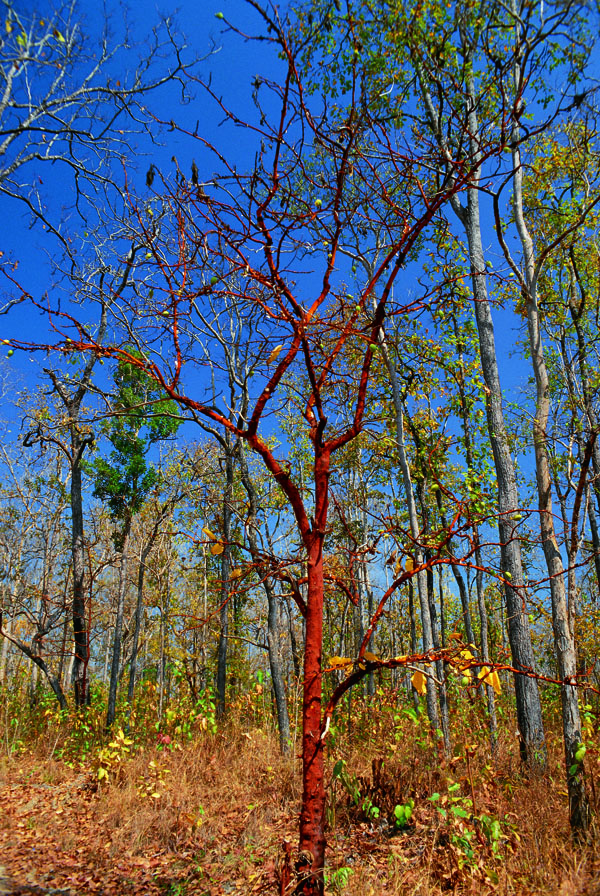
Page 38-39
Dry deciduous dipterocarp forest that is common in the sanctuary. The red tree, Gardenia erythroclada, in the foreground is found all over this forest. Many species of wildlife thrive here. From the road inside the sanctuary, it is quite common to see barking deer and wild pigs, and sometimes a leopard.

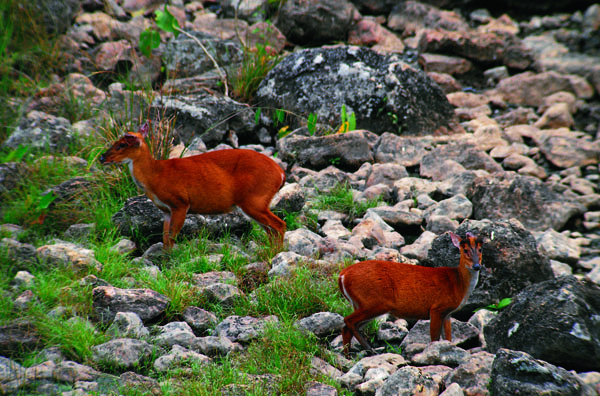
Page 39
Common Barking Deer at a hot spring to take in minerals. The mature male (above) has a perfectly shaped set of antlers whereas the females (below) have none. Although common throughout Thailand, these deer are hunted for their meat. They can coexist with man but are mostly nocturnal in their feeding habits and hide during the day.Many other animals visit this area including gaur, banteng, tapir, sambar, wild pig, leopard and tiger.
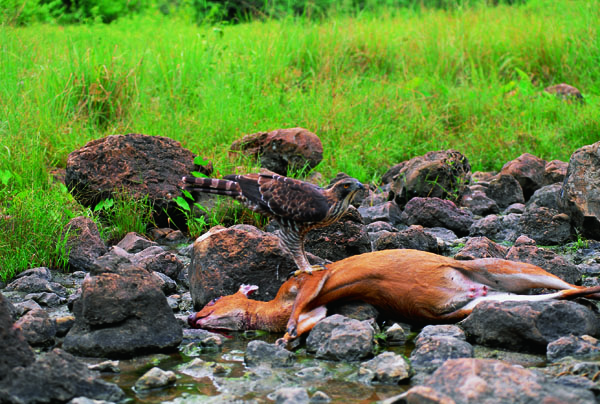
Changeable Hawk-Eagle Spizaetus cirrhatus on a barking deer carcass at a hot spring. The deer was probably killed by a pack of Asian wild dog and then abandoned, a common trait of these predators but also may have succumded to nature. These large birds have broad wings and long tails. They glide and soar, always looking for a meal. Hawk-eagles are predatory and sometimes scavenge.
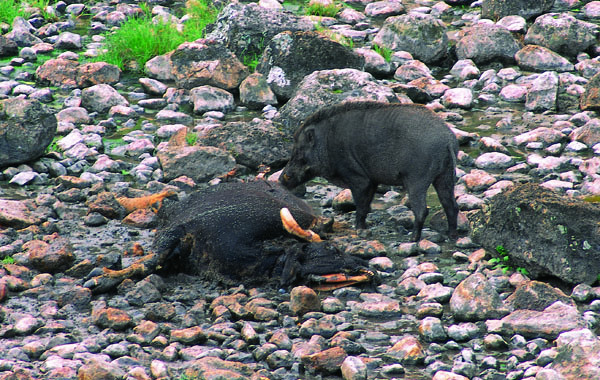
Page 40
Wild Pig Sus scrofa (above and right) at a mineral lick. Pig is a prey species of tiger, leopard and wild dog, but they have also been known to be killed by a large solitary boar. Wild pig are omnivorous and feed on fungi, roots, bulbs, shoots, snakes, invertebrates, rats, carrion, and many different types of fruit and vegetables cultivated next to forests. The carcass (bottom left) is that of a gaur. The wild pig is quite common in Thailand’s forests but is poached for its meat and trophy tusks.


Page 41
Wild Pig Sus scrofa at a mineral lick. Pig are prey species of the tiger, leopard and wild dog, but they have also been known to be killed by a large solitary boar. Wild pig are omnivorous and feed on fungi, roots, bulbs, shoots, snakes, invertebrates, rats, carrion, and many different types of fruit and vegetables cultivated next to forests. The carcass (top) is that of a gaur. The wild pig is quite common in Thailand’s forests but is poached for its meat and trophy tusk.

Page 42
Crab-eating Mongoose Herpestes urva hunting for aquatic animals in a hot spring. This animal can squirt an odoriferous fluid from an anal gland with great force, much like the North American skunk. It weighs about 3-4 kilograms and is much larger than the more common Javan mongoose that is found all over Thailand. The crab-eating mongoose is a fearless little carnivore that does not hesitate to enter water in pursuit of prey and is an excellent swimmer.
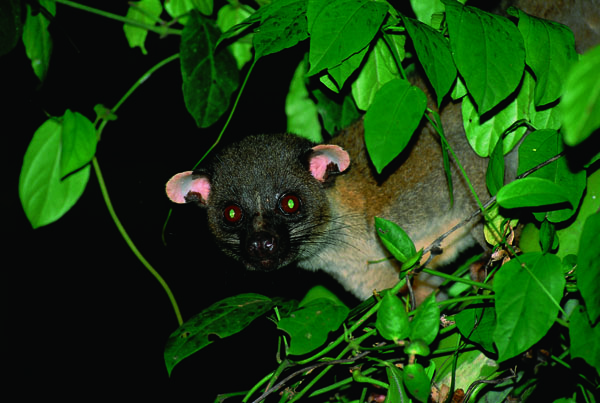
Three-striped Palm Civet Arctogalidia trivirgata. This little carnivore gets its name from the three longitudinal stripes along its back. It also has a thin stripe on the nose and distinctively shaped ears. This creature is nocturnal and arboreal, preferring deep forest away from humans.

Hog Badger Arctonyx collaris. This nocturnal carnivore has a piglike nose, short tail, white throat and sharp claws. It is terrestrial and sleeps in burrows during the day. Notoriously savage when attacked, and gifted with a tenacity for life, it is one of Thailand’s many strange-looking mammals.

Page 43
Large Indian Civet Viverra zibetha. This magnificently marked civet is sturdily built. Being a carnivore, it eats fish, birds, lizards, frogs and insects, and has been known to scavenge garbage dumps and raid poultry farms. They have a strong distinctive scent that comes from its perineal gland.
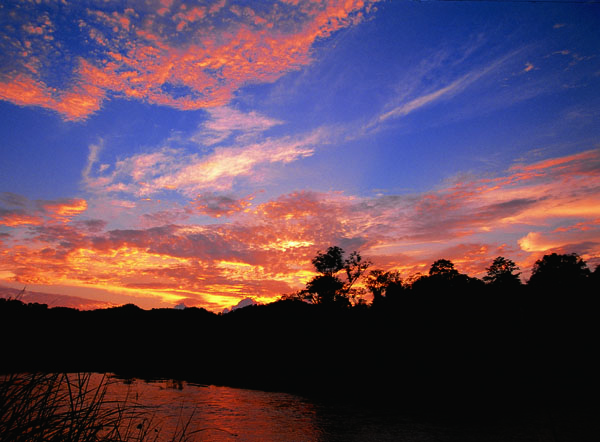
Page 44
Sunset at Khao Ban Dai guard station in the central sector of the sanctuary. The area often affords some magnificent sunrises and sunsets as moisture in the atmosphere, drawn from the forests, creates a superb array of colours and hues.

Page 45
Huai Kha Khaeng and Huai Mae Dee junction at Khao Ban Dai ranger station. Sambar, green peafowl and crab-eating macaque come to the river almost daily. Occasionally a tiger or wild pig will cross.

Page 46
Phayre’s Langur Presbytis phayrei. Two langurs feeding on a berry tree in Huai Kha Khaeng. Groups of these long-tailed leaf monkeys, ranging from about a dozen to more than 40 animals, have been seen, as well as solitary creatures that have left the troop. They come down from the trees to drink at mineral springs that cause gallstones that are used in Asian medicines. This, and the fact that their meat is considered a delicacy by some, means that they are heavily poached in the west and north of Thailand.
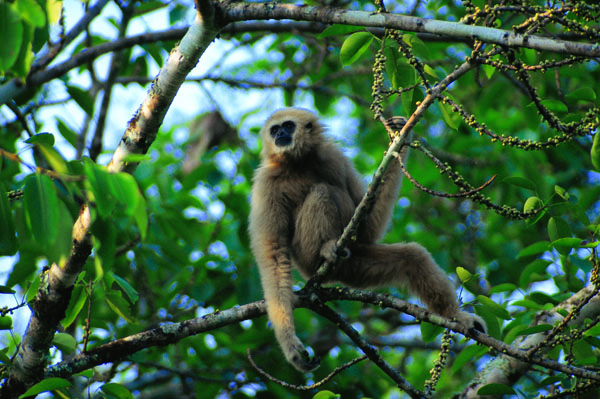
White-handed Gibbon Hylobates lar in a fruit tree (top). They have white hands and feet, hence their name, and a white ring around the face. Gibbon are dark brown to black or blond to very light brown. The musical “whoop-whoop” call of the species when the sun comes up is a reassuring sign that the forest is more or less intact.
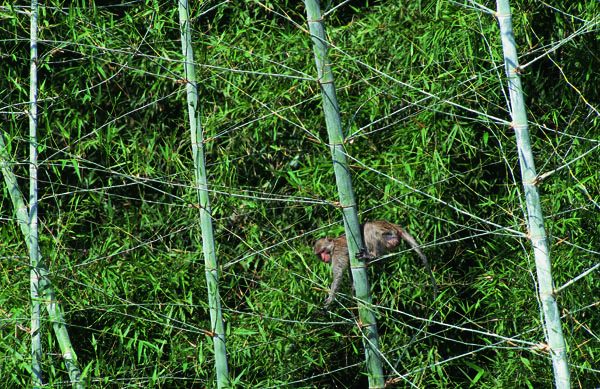
Page 47
Crab-eating Macaque Macaca fascicularis in bamboo ((lower). This monkey is feeding on the tender shoots in the early morning along the Huai Kha Khaeng. Macaque, a prey species of the leopard, are constantly on the alert for the feline.

Page 48
Black Giant Squirrel Ratufa bicolor. This is Thailand’s largest squirrel. It usually comes out midmorning to feed on fruit and nuts. Black with yellow under-parts, its tail is over a foot long. Extremely wary, it will disappear into the trees at the slightest hint of danger.

Page 49
Belly-banded Squirrel Callosciurus flavimanus. This little mammal was photographed at the sanctuary’s headquarters area. Many squirrels can be seen quite easily in the morning, feeding on fruit and nuts. Thailand has some 27 species of squirrel including flying squirrel.
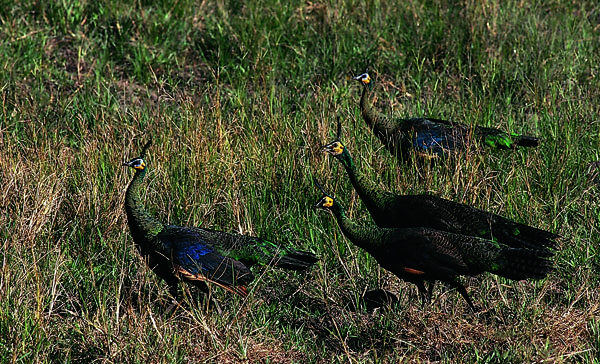


Page 50

Page 51
Green Peafowl P. Muticus in November, during the breeding season. The females (top) are being shown magnificent courtship by the male (below). The male’s trumpet call is very distinctive and can be heard over long distances at early morning and dusk.The male, female and two chickswere photographed at midmorning near Kreung Krai, close to the mouth of the Huai Kha Khaeng. Peafowl are breeding here and their numbers are stable at the moment. However, they have disappeared from all other areas of Thailand with the possible exception of a few in Mae Yom National Park, Phrae province, and the Salawin Wildlife Sanctuary in Mae Hong Son province.

Photo by: Loong Waitnayakarn
Brown Hawk-Owl Ninox scutulata. This group is comprised of two young chicks with the parents on either side. They often stay together for some time after leaving the nest, eventually splitting up to live solitary lives until the mating season. Like all owls, they are nocturnal and have forward-facing eyes, with a facial feathered disc to locate prey at night.

Photo by: Kwanchai Waitnayakarn
Page 52
Collared Scops-Owl Otus lempiji. These birds of prey are seldom seen as they roost in deep cover during the day and only come out at night to feed on various birds, rodents and other small animals. Occasionally, they can be seen during the day but those occurrences are rare.
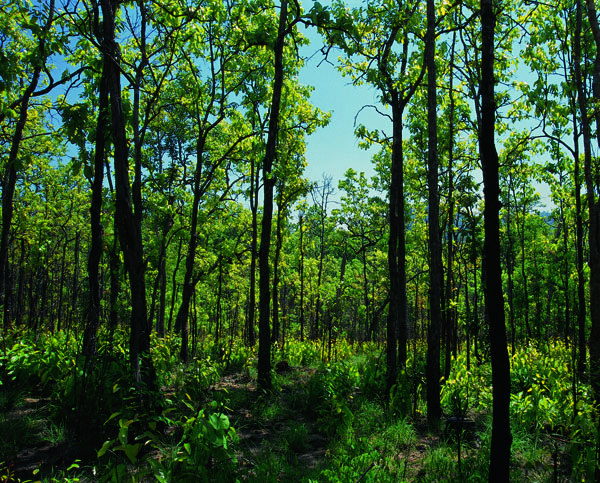
Page 53
Dry deciduous dipterocarp forest, in the central area, that has just turned green after the first rains in May. This area catches fire during the dry season, almost every year. Areas of evergreen forest are also damaged by fire. Animals often perish in such fires. The underlying danger is posed by the excessively dry seasons that have recently become common. The apparent trend towards a drier climate in Thailand may well be part of global warming and climate change, itself caused in part by forest destruction.


Page 54-55
Blue Magpie Urocissa erythrorhyncha at Khao Ban Dai guard station (lower). This beautiful bird is also very noisy, flying through the forest with a resounding cha-chak, cha-chak. It is a common forest bird, especially in Thailand’s western and northern deciduous and open evergreen woodlands. The photo (top) shows a parent removing chick droppings from the nest. Housekeeping is common among many species of bird, keeping nests clean, and free of insects. Both male and female magpie parents look after the chicks.

Page 56
Blue-bearded Bee-eater Nyctyornis athertoni. This rather large bird nests in dirt banks. Having long, curved and narrow bills, slender bodies and long pointed wings, they feed on bees and other insects caught in flight by hawking from an exposed branch.

Black-naped Monarch Hypothymis azurea. This male is incubating the eggs. With their bright blue plumage, black nape and gorget, these birds are common residents and partial migrants during winter. Their habitat includes deciduous and evergreen forests, secondary growth and open woodlands up to 1,200 meters.

Page 57
Green-billed Malkoha Phaenicop-haeus tristis. This adult is removing chick droppings. The red eyepatch is the bird’s most striking feature. Its plumage is a drab gray-green. This large bird is quite common throughout the country, but the five other species of Malkoha are restricted to the rainforests of the southern peninsula.

Page 58
Brown Hornbill Ptilolaemus tickelli. This large bird is on the ground, feeding an insect to its mate inside the nest. It is rare to find hornbill this far down within the forest canopy. Its size is comparable to the oriental pied hornbill, and feeding habits are similar. They eat fruit, insects and small animals like frogs and snakes.
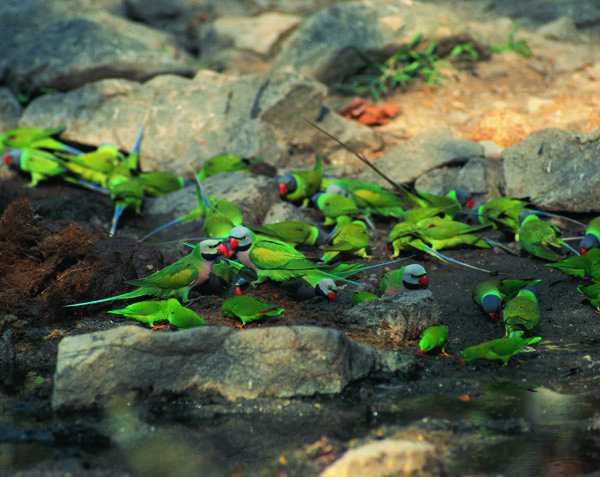
Page 59
Red-breasted Parakeet Psittacula alexandri and the smaller Vernal Hanging Parrot Loriculus vernalis. This mixed flock is at a mineral lick in the central area of the sanctuary. These two species and some pigeon visit the lick daily, sometimes twice, to take in pebbles and minerals.

Page 60
Banded Broadbill Eurylaimus javanicus with an insect. This is probably the most striking of the seven species of broadbill, with its beautiful crimson breast, black with yellow spotting on the wings and a turquoise bill. Difficult to observe and an uncommon resident, this broadbill is one of the loveliest examples of an arboreal bird.

Page 61
Crimson Sunbird Aethopyga siparaja. The 15 different species of sunbird in Thailand are found from sea level all the way up to the highest mountains. Basically like the New World hummingbird, they are not as vigorous in hovering and flight. These very small birds use their curved beaks to eat nectar and insects. They flit about the forest with endless energy.

Page 62
Lineated Barbet Megalaima lineata feeding on a berry tree at Khao Ban Dai guard station. This barbet is one of the most common of the 13 species found in Thailand. It is frugivorous and normally stays in the upper canopy of the forest. Barbet are heavy-bodied birds with large heads and stout bills.
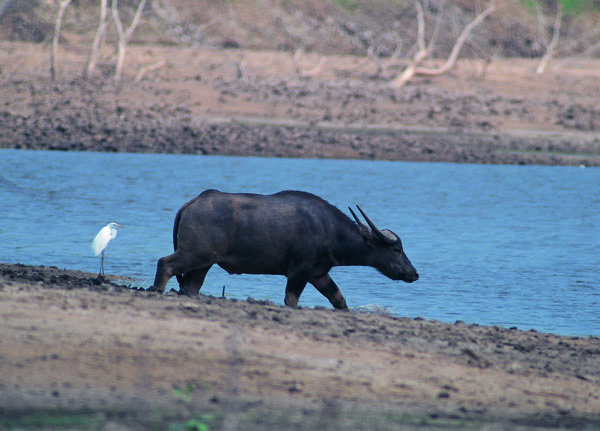
Page 64
Great Egret and Wild Water Buffalo bull on the river near Kreung Krai, close to the upper reaches of the Sri Nakharin dam and reservoir. Innocent and unaware of the man-made perils around them, they face an uncertain future at the hands of poachers and encroachment.

Page 66
Red Junglefowl Gallus gallus hen with her two chicks at the river. These wild chicken, the ancestors of the domesticated variety, are always extremely wary and can fly away out of danger very quickly, flapping their wings and squawking loudly. Red junglefowl are found all over Thailand but are heavily poached for their meat.

River Lapwing Vanellus duvaucelii of the plover family. This medium-sized wader lives along the lower reaches of the Huai Kha Khaeng. They act as sentries for the wild water buffalo that also live in the area. An uncommon water bird seen only in a few rivers around the country. Very wary and difficult to photograph.

Page 67
Hoopoe Upupa epops. This medium-sized bird with its long beak, crest and striking colors can be found in many countries around the world. Feeding mostly on grubs, it nests in cavities of trees and in earth banks.

Page 69
Water Monitor Varanus salvator swimming along the Huai Kha Khaeng. Water monitor lizards live in a riparian habitat and are very good swimmers. They eat anything they can catch, including fish, birds, other reptiles, small mammals, and any carrion they find. They grow up to two meters in length and can weigh more than 50 kilograms. These reptiles are still found in many places in Thailand, even in the khlongs (canals) around Bangkok.

Page 70-71
Gaur B. gaurus in mid-afternoon at a mineral lick. This magnificent solitary bull, estimated at 12 years old, has worn his horns down at the tips and damaged the bases from years of fighting with other bulls. Truly in his prime, he has survived danger all his life. Gaur are the world’s largest bovid species.

Page 71
Banteng B. javanicus and Gaur B. gaurus bulls grazing on lush grass during the rainy season. This photo of two different species of bovid is rare as normally they are not seen together. However, banteng and gaur have been seen together in Huai Kha Khaeng on occasions at several mineral licks in the sanctuary. Mature banteng bulls have a slightly smaller body size, hooves and horns then gaur bulls of equal maturity. These two bulls probably keep together for added security against tiger attack.
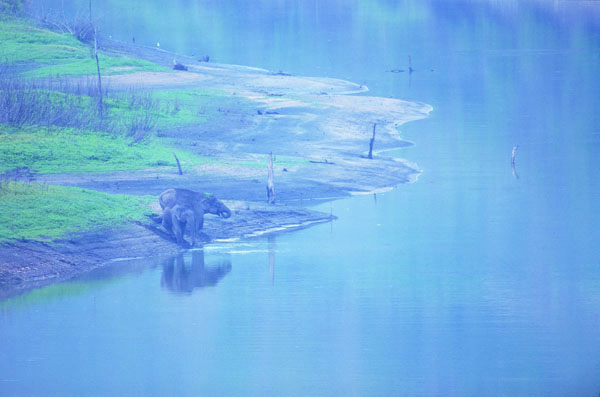
Page 72-73
Asian Elephant E. maximus drinking water in the late afternoon at the mouth of the Huai Kha Khaeng, unaware of their uncertain future. These two and others are seen regularly around the Kreung Krai station. Note the desolation at the drawdown area of the Sri Nakharin reservoir.
To be continued in Part Two..!
Mountains of the North
Majestic beauty, rugged granite massifs, fertile forests, steep terrain, thunderous waterfalls and sparkling waterways
Satellite map of Northern Thailand, Burma and Laos
Doi Inthanon National Park
Some 60 million years ago, the sub-continent India moving on tectonic plates crashed into the Asian mass that created a ripple effect across Southeast Asia, and many mountain ranges up-lifted forming over time. Most of these run from north to south creating a blanket upshot across northern Thailand plus areas in Burma and Laos.
Mountains in Mae Hong Son province
This terrain is divided into many mountains and valleys with rivers that bring life to the region and the people. The North is essentially a series of mountain ridges folded between two mighty off shoots of the Himalayan Range: The Dawa-Tenasserim in the West and the Annamite Range in the East.
Goral jumping in Mae Lao-Mae Sae Wildlife Sanctuary
The prehistoric significance of animal and plant life is a treasure trove of ancient creatures now extinct. From 80,000 to 140,000 years ago, the giant panda lived in these mountains. Fossil remains have been found in a cave in Mae Hong Sorn by palaeontologists from the Department of Resources with French counterparts. Rhino were common and many remains have come forth.
Wachiratan Waterfall in Doi Inthanon
Going back even further to 10 million years ago, ancestors of the orang-u-tang thrived here and fossil-teeth of these great apes have been uncovered in lignite mines in Phrayao district of Chiang Rai. The rainforests were thick vegetation and ecosystems had a vast array of flora and fauna.
Salaween River in Mae Hong Son province
Approximately 4,000-5,000 years ago, a small group of Hoabinhians (named by archaeologists) or ‘Stone Age’ man were hunter-gatherers, and lived in a narrow valley named Ob Luang gorge southwest of Chiang Mai. These people camped under a rocky ledge near the Mae Chaem River and left red and white cliff drawings depicting the wildlife at the time. The fragmented remains of these prehistoric paintings can still be seen today. These people used stone tools, and depended heavily on wild animals for subsidence.
Siriphum Waterfall in Doi Inthanon
During the Bronze Age, people established permanent settlements nearby, leaving behind signs of civilization using bronze tools, jewellery and pottery. With more advanced weapons, they began to decimate the wildlife and clear the forests for agriculture and a settled existence. With the advent of the Iron Age and increased populations and better weapons, hunters began to have a significant impact on the surrounding flora and fauna. Forest clearing increased as populations became bigger. Settlements along the rivers were the first to be colonized.
Wild boar in Om Koi Wildlife Sanctuary
In the old days, large carnivores like the tiger, leopard and bear were found in all these thick forests. Huge herds of gaur, banteng and elephant lived off the profuse vegetation and proliferated. These mega-fauna lived in the precipitous mountains and thrived on abundant food sources and mineral deposits for supplements. Wild flora and fauna was extremely plentiful and at one time was taken for granted.
Prancing muntjac in Om Koi Wildlife Sanctuary
Around the beginning of the twentieth century, northern Thailand’s many beautiful mountain ranges and valleys were covered with extensive natural teak and deciduous forests. Unfortunately, much of the area has since been heavily logged, cultivated and/or encroached upon.
Orchids in Doi Inthanon
Humans laid siege to the land. When logging concessions were in full swing, living off the land as the loggers penetrated deeper and deeper into virgin forest tracts literally wiped out many places before the logging ban in 1989 and prior to conservation and protection came into play. The logging companies reaped in the profits from the natural resources that had evolved over millions of years. This sad chain of events shows this destruction layed upon the land and the effects of poor watersheds with only fair water retention ability after large scale flooding downstream from the North last year.
Staghorn beetle in Doi Inthanon
At the beginning of winter during November in the north of the Kingdom is a time of beauty. The skies are normally cloudless blue and the weather is crisp and cool. Early morning fog blankets the lower valleys, and rivers and streams run crystal clear. It is at the end of the rainy season and waterfalls cascade down mountain slopes and moisture is 100 percent.
Chiang Saen Lake in Chiang Rai province
In some areas, animals like goral and serow (rare goat-antelopes) still live on rocky crags while deer, wild pigs and wild dogs flourish in steep forests. Birds, insects, reptiles and amphibians plus a huge array of plant life continue to exist. The balance of nature reigns supreme as nature intended. But these biospheres are under greater pressure as time passes on.
Whistling ducks in Chiang Saen lake
For this story, all the provinces from Tak and Uttaradit up to Chiang Mai, Lampoon, Lampang, Mae Hong Sorn, Chiang Rai, Phrae and Nan are blessed with these unique ecosystems. In Thai, ‘doi’ means mountain. The North’s original pristine beauty however now remains primarily in only a few protected areas, the most important of which are described below:
Doi Inthanon National Park
Sunset over Doi Inthanon
Doi Inthanon is Thailand’s highest mountain rising to 2,595 meters, and is part of the Thanon Thongchai Range that extends south from the Shan hills of Burma to the province of Tak. Situated southwest of Chiang Mai, this 482 square kilometre national park was gazetted in 1972 and is now one of the most visited parks in the country. The Royal Thai Air Force maintains a radar station at the peak and the Department of National Parks (DNP) is responsible for the park. This site is visited heavily by Thai and foreign tourists due to its significance as the highest place in the country.
The park’s geology of granitic batholith enables it to support several different types of forest. The most notable of these is at the peak where montane evergreen forest abounds. Native pines grow at the moderate to higher elevations and a sphagnum bog exists at the summit, the only one in Thailand. Important species are the green-tailed sunbird, which is endemic here, and the Himalayan newt (crocodile salamander) found in the bog.
Doi Inthanon National Park was once under full forest cover and wildlife found around the mountain included elephant, gaur, banteng and tiger that was very common here about 50 years ago. However, most of the larger fauna have disappeared due to poaching and encroachment by the hill-tribe and lowland people. A few sambar (Thailand’s largest deer) and smaller mammals like barking deer, wild pig, black bear and a few primates can still be found but all in very small numbers. Goral and serow still survive on Kew Mae Pan cliff-face. Birds predominate the landscape and there are some 383 species that have been recorded here. Doi Inthanon is one of the top bird-watching sites in Thailand.
The influx of hill tribes, first Hmong and later Karen with their practice of slash and burn agriculture has decimated the forests from 1,500 meters down to the lowlands. Opium was once the Hmong’s main cash crop but has now been replaced by rice, vegetables, flowers, fruit and coffee. In the old days, the Karen people were mainly hunters and filled the pot with anything edible. With an ever-increasing population who now use modern agricultural techniques and mechanized transport, this park is under serious threat as the population increases. There is nowhere to go except to expand outwards.
Like most protected areas in the country that have people living in them, it seems that parts of Doi Inthanon have degenerated to the point of no return. The park has been overcome by modernization and it will continue to decline. Probably the most destructive is the amount of pollution generated by vehicles (cars, vans, pick-up trucks and buses) plying the road daily in the thousands that continues to increase. Recent surveys of birds have encountered a drop of some 50 percent over the last 10 years. Unfortunately, it is a downhill run to extinction for many species of flora and fauna at this location.
Doi Suthep – Doi Pui National Park
Sunset over Doi Suthep – Doi Pui National Park in Chiang Mai
The twin peaks of Doi Suthep and Doi Pui, west of the city of Chiang Mai rise from the valley floor to heights of 1,601 and 1,685 meters respectively. The 261 square kilometre national park was finally gazetted in 1981. Unfortunately, due to its proximity to the city, it has been extensively logged and poached for everything it contains. Wild orchids, other flowers and plants, plus mammals, birds have been the prime targets. Once upon a time, elephants, gaur and tiger were common but were quickly decimated by the nearby population.
The park contains two waterfalls, Huai Kaeo and Monthathan that the locals use for recreation. Several Buddhist temples dot the park, the most famous being Wat Phra Borommathat Doi Suthep that is visited by tens of thousands of local and foreign tourists each year. The road at the top to Phu Ping Palace has been widened and other road surfaces have been improved. Continued pressure on the park from more and more traffic and visitors can only have an adverse effect in the long term.
Mae Tuen and Om Koi Wildlife Sanctuaries
Situated in Tak and Chiang Mai provinces respectively, these important contiguous sanctuaries together cover an area of some 2,397 square kilometres. They thus constitute the largest conservation area in northern Thailand. They are bordered to the east by the Mae Ping National Park that is bisected by the Ping River flowing into the Bhumibol reservoir in Tak province. Unfortunately, the lake acts as a gateway to the sanctuaries and park by allowing easy access by boat. The locals are allowed to fish the reservoir but poaching and gathering continues to be a problem for the DNP.
Goral is found here too with a dozen or so animals on Doi Montjong in Om Koi Wildlife Sanctuary. Unlike the serow, which is found more widely in Thailand, the goral is highly endangered. Its future is grim indeed as many Hmong and Karen hill tribes still live within the sanctuaries, engaging in poaching, encroachment, and slash and burn agriculture. This is also one of the last sites in the North for wild elephant. Only a few herds remain. Gaur and banteng are reported but their numbers are few. As time marches on, they could eventually disappear from these two sanctuaries that together constitute the largest northern refuge for Thailand’s large mammals. Very few surveys have been conducted here.
Smaller parks and sanctuaries
There are many other areas in the north that have been designated as national parks, wildlife sanctuaries and non-hunting areas. Of these, the most notable are Mae Lao-Mae Sae and Doi Luang Chiang Dao wildlife sanctuaries in Chiang Mai province, another haven for goral; Namtok Mae Surin National Park, and the Salawin and Lum Nam Pai wildlife sanctuaries in Mae Hong Son province; Doi Khun Tan and Namtok Chae Son national parks in Lampang province; Mae Yom National Park in Lampang and Phrae provinces; and Chiang Saen Lake Non-Hunting Area in Chiang Rai. All these and many other sites not mentioned here are like the rest persecuted by a small minority of people who seem intent on continuing to abuse Thailand’s natural resources for their own benefit. As human populations in the north continue to increase, encroachment into protected areas becomes more difficult to control. The future seems bleak.
Looking back, trying to apportion blame for the enormous damage that has been wrought would be rather like the pot calling the kettle black. Yet if we could turn the clocks back 100 years, and if all those responsible had used careful selective cutting and true conservation techniques, most forests could have been saved. Dwelling on hindsight is thought by many to be a waste of time. Yet hindsight provides us with valuable knowledge, if only we take a little time and trouble to learn from the mistakes made by those who came before us. Using that knowledge today will enable us to save Thailand’s remaining natural treasures for our children and future generations.
Hornbills: Indicator species of an intact ecosystem
WILD SPECIES REPORT
Majestic birds and living fossils
Wreathed hornbill in Kaeng Krachan National Park
Most people are familiar with the hornbill, nature’s amazing avian fauna with large bills and a casque, and some with raucous calls. They also have strange but interesting nesting habits and the larger hornbills make a loud whooshing noise when flying sounding much like a locomotive, and heard from quite a distance. In any given forest, if they thrive it means the ecosystem is fairly intact.
Brown hornbill at a ground nest hole in Huai Kha Khaeng
The hornbill belongs to an ancient family (Bucerotidae) of birds seen in fossils from the strata of the ‘Eocene’ period of Europe some 50 million years ago. Through tectonic-plate movement, hornbills however have become restricted to tropical Africa and Asia, and there are 55 species found in the world with 24 in Africa and the rest surviving in the forests of South and Southeast Asia. Thailand has twelve species recorded throughout the country, and all still thrive but some are endangered.
Wreathed hornbill with fruit for his mate in the nest
These noisy, social, omnivorous birds need large tropical forest areas with many fruiting trees throughout the year to survive. Giant emergent trees with nesting cavities are also important to carry on their legacy but some species nest near the ground. The diet of the hornbill is a preponderance of figs and other fruits but also take animal food such as snakes, lizards and small bird hatchling needed for dietary protein when rearing the chicks.
About six years ago, my dream to photograph hornbills at a nest became a reality. The month is May and I’m sitting in a hot, humid blind in the dry evergreen forest of Kaeng Krachan National Park. The location is near the 9th tier of Thor Thip waterfall about 10 kilometers from Phanern Thung ranger station in the interior of the protected area.
Great hornbills flying off a fig tree
A pair of wreathed hornbills was sighted coming and going from a nest-hole by a forest tour guide, and relayed to my close friend Suthad Sappu who has been a ranger with the park for more than 15 years, who informed me and I made immediate plans to make a visit. It took me a few days to get going and I finally loaded up my old 4X4 pickup truck making my way out of Bangkok to Phetchaburi province in southwest Thailand, a three-hour ride.
We eventually arrived at the end of the road at Kilometer 36 and immediately got ready for the 4-plus kilometer walk downhill to the waterfall along a well-established nature trail. On a hill across from a tall tree with a large hole in it, I quickly set-up a blind and went into hiding.
Rufous-necked hornbill in Mae Wong National Park
A pair of wreathed hornbills chose this cavity for their nest. By the time I got there, the female was already inside and the front had been closed-in with droppings. This chore is taken care of by the female so that just a small slit is left. The perch above the hole is just right to allow the male to feed the occupants with fruit and small animal morsels.
In a short while, a loud whooshing noise was heard and the male hornbill arrived as the morning light glowed. The large bird popped out fruit and gingerly fed the female. It was a beautiful experience seeing and photographing this great natural spectacle. After filling my card with digital images, I waited until the bird left on another fruit gathering mission and then left quietly. As always, this sighting is etched in the old memory bank.
Wrinkled hornbill in Hala-Bala Wildlife Sanctuary
The chicks eventually hatched and the cycle of life began for yet another group of hornbills. The female finally emerged and left the young ones in the nest for a while longer as the adults continued to feed them. One day, they eventually outgrew the nest and broke free. It is one of the greatest success stories of the natural world.
Hornbills unfortunately have been persecuted for their large bill and casque as an ornament. Poachers for subsidence also eat these large birds. This has greatly impacted all species of hornbill throughout the Kingdom but there are still many protected areas where they can be found. Many are near extinction at the hands of man in his quest to survive with the destructive forces of encroachment and poaching.
White-crowned hornbill in Hala-Bala
In 1996, Japanese photographer Atsuso Tsuji published an excellent book in conjunction with Sarakadee Press entitled ‘Hornbills – Masters of Tropical Forests’ about these amazing creatures. This tome is now out of print but probably can be found in some used bookstores. With many photographs and text, he delves into the lives of hornbills in Khao Yai National Park. There are chapters on nesting, roosting and feeding habits, and in particular the entire life cycle of hornbills.
A story about hornbills in Thailand would not be complete without mentioning biologist Dr Pilai Poonswad with Mahidol University who has dedicated her life to the study and research of this magnificent avian fauna, and she has also published a scientific journal concerning the subject. Her work has included helping hornbills to choose nest holes by installing a ledge just below the cavity to allow these large birds to perch easily while feeding the female and chicks inside.
Great hornbill in Khao Yai National Park
I was very fortunate to photograph a great hornbill male in Khao Yai while it visited a nest very close to the main road in the park shown in the story. Ajarn Pilai and her team has also worked in other protected areas like Huai Kha Khaeng, Hala Bala and Khlong Saeng wildlife sanctuaries, and Keang Krachan and Khao Sok national parks plus many others throughout Thailand to monitor these birds, and she has established the Hornbill Research Foundation to further the study and protection of these majestic animals.
Down south in Surat Thani in the rich forests of Khlong Saeng next to Khao Sok, I did a camera trap survey deep in the interior catching many animals including a white-crowned hornbill down on the ground next to a large waterhole shown in the story. I also photographed a brown hornbill at a nest hole on the ground in Huai Kha Khaeng.
Oriental pied hornbills in Kaeng Krachan
My close friend Sarawut Sawkhamkhet photographed a pair of Oriental pied hornbills at a waterhole in Kaeng Krachan. Another fellow wildlife photographer Saman Khunkwamdee photographed helmeted and rhinoceros hornbills many years ago down in Hala-Bala Wildlife Sanctuary during peacetime in Southern Thailand on the border with Malaysia. Another close friend Vanchai …….a has photographed all 12 species, quite a feat and just recently visited Hala-Bala capturing the very rare wrinkled hornbill and others in the sensitive south.
The future of the hornbill in Thailand is the same for all species that inhibit pristine forests; they must be protected at all costs from destruction by encroachment and poaching. This responsibility rests with the Department of National Parks, Wildlife and Plant Conservation, and it is imperative that the management, protection and enforcement is greatly improved so that the magnificent protected areas remain intact. The government and private sector should work together to insure hornbills and all the other creatures and ecosystems remain part of Thailand’s amazing natural heritage.
Oriental pied hornbill with fruit for its mate
According to the very informative ‘Birds of Thailand’ by Boonsong and Round, there are 12 species of hornbill found in Thailand as follows:
1) White-crowned hornbill (Berenicornis comatus) with a bushy white crest and blackish bill and a small casque. Habitat is evergreen forests from foothills to 1000 meters, and is an uncommon resident.
2) Brown hornbill (Plilolaemus tickelli) is relatively small in size and brown plumage with white orbital skin and yellowish bill and small casque. Found occasionally in mixed deciduous forest adjacent to evergreen forest up to 1,500 meters. They are an uncommon resident.
3) Bushy-crested hornbill (Anorrhinus galeritus) has mainly black plumage with a small casque and a thick, drooping crest and pale blueish gular and orbital skin. Found in evergreen forest from the plains to 1,000 meter. They are fairly common resident.
4) Rufous-necked hornbill (Aceros nipalensis) is identified by a combination of bright blue orbital skin and bright orange-red gular pouch, and yellowish ivory bill with no casque. Found in evergreen and hill evergreen from 600 meters to 1,800 meters, and is a rare resident.
5) Wrinkled hornbill (Rhyticeros corrugatus) has all black wings and is distinguished from wreathed hornbill by smaller size. Yellowish bill and small reddish casque. White gular pouch in males and blue gular pouch in males. Found in lowland evergreen forest in the South. Rare with just a few left in Southern Thailand due to habitat destruction.
6) Wreathed hornbill (Rhyticeros undulates) shows all black wings with a white tail, and black bar on gular pouch that is yellow in males and blue in females. Diagnostic corrugations on sides of both upper and lower mandibles. Found in evergreen and mixed deciduous forests from the plains to 1,800 meters. They are an uncommon to locally common resident.
7) Plain-pouched hornbill (Rhyticeros subruficollis) in coloring is similar to the wreathed hornbill but distinguished by slightly smaller size. Lacks corrugations on sides of bill. Found in evergreen and mixed deciduous forests of the lowland and lower hills. They are a rare resident.
8) Black hornbill (Anthracoceros malayanus) is small in size with all black plumage with white tips on tail feathers. The bill is yellowish white in the male and blackish on the female and both with a whitish cassque in both sexes. They are found in evergreen forests in the plains and foothills, and are a rare resident.
9) Oriental pied hornbill (Anthracoceros albirostris) is identified by its small size, whitish face patches, white lower breast and belly. The bill and casque is ivory-colored and marked with black with casque larger in males but more heavily marked blackish in females. Can be found in evergreen and mixed deciduous forests and secondary growth from the plains up to 1,400 meters, and is a fairly common resident.
10) Rhinoceros hornbill (Becerous rhinoceros) is very large and mainly black with a white belly and tail marked with broad black band. Large upturned casque is reddish and bill yellow, and is lighter in color on the female. They are found in the extreme south of Thailand in evergreen forests from lowlands up to 1,200 meters, and are a rare resident.
11) Great hornbill (Becerous bicornis) is very large and is easily recognized by golden-stained white wing bar and white trailing edge to wing and by white tail with black band. Red eye in males and white eye in females. Mainly with a yellow bill and casque. They are found in evergreen and mixed deciduous forest from plains up to 1,500 meters and found on some offshore islands. Uncommon to locally common residents.
12) Helmeted hornbill (Rhinoplax vigil) is large with a elongated central tail feathers. Blackish brown with a white belly. Short conical bill and rounded casque is red. They are found in evergreen forests from plains up to 1,200 meters and is, an uncommon to rare resident.
The ‘Big Five’ in five days – Part Two
Africa’s great wildlife adventure – continued
Sunrise over Mount Kenya at ‘Sweetwaters’ Wildlife Reserve
The safari so far had been hectic and we had taken loads of photographs. On day seven, our next destination was a private reserve not far from Mount Kenya in the central provinces. The weather was crisp and chilly when we arrived at ‘Sweetwaters Game Reserve’. As we were checking into the lodge, a small herd of reticulated giraffe visited the waterhole next to the hotel. We left our bags and departed for our first game drive and saw more giraffe plus wart hog and zebra.
African fish eagle grabbing a fish – this was a setup where the locals call the eagles in and as they swoop down, the photographer is suppose to catch them in mid-flight. It was not easy and I burned a lot of card space but got one shot. Not easy!
This lodge is a tented camp and the services are amazing. In each bed, a hot water bottle is placed under the covers by the staff in the evening as the temperatures can sometimes drop dramatically during the night close to freezing. Mount Kenya is snow-capped year-round and the weather is always very pleasant here. The mountain is a beautiful sight when the cloud cover clears.
That night at dinner, a small herd of white rhino arrived followed by a family unit of elephant. Just about everyone left their dinner to photograph the huge herbivores. That night, I photographed a male impala that jumped the electric fence to nibble on the soft grass inside the hotel grounds.
Lion pride on the savanna
The next morning, I was up at the crack of dawn setting up my camera with a wide-angle lens to shoot the sunrise with the Mount Kenya range in the background. At 6:30am after a quick cup of coffee, we departed for the morning drive. We bumped into a mother lion and two small cubs. The female had a collar with a radio transmitter and was being monitored by the park’s research staff.
We left after lunch for the last leg of the safari. Our destination was several hundred kilometers to the east and Samburu National Reserve was entirely different from the three previous locations. It was lowland desert; hot, dusty and dry but still loaded with wildlife. The Samburu Game Lodge was very comfortable and located at the banks of the Eweso Nyiro River.
As we entered the park, a herd of giraffe crossed in front of us followed by a large herd of elephant that went down to the river for a refreshing drink and cooling bath. The African giants then sprayed dust over their backs to ward off insects.
Leopard mother and cub in Samburu National Reserve
Over the next two days, we managed to get leopard once again. This time it was a mother and cub feeding on a little male dik-dik, Africa’s smallest antelope. We also photographed Grevy’s zebra, giraffe, waterbuck, gemsbok and gerenuk plus the dik-dik. Elephant were everywhere and easily approached.
When the rains came earlier this year, the river overflowed its banks and washed out the only bridge in the park. We were not able to visit the other side where the lions and buffalo live. There were many crocodiles in this river and two would come up at night into a closed pen next to the bar in the lodge.
On our departure, we saw a large group of vehicles surrounding a tree and decided to investigate. It was on the way out. Up in a tree, a male leopard was sleeping off a previous kill.
African elephant herd in Samburu
It was strange how we bumped into a leopard on the first day and on our day out. The leopard is considered to be the toughest to see and photograph while on safari but we were lucky. The ‘spirits of the wild’ had smiled on us.
The long ride back to Nairobi took about 6 hours and we finally arrived at the hotel tired, dusty and hungry. The next morning we flew to Lamu, a World Heritage Site on the northeast coastline for some rest and sightseeing. This old town was a port during the slave-trading days and its rustic appeal off the beaten track was interesting.
Elephant family group by the Eweso Nyiro River in Samburu
These events are etched in memory and I know I have caught the African bug. I am leaving on another photographic safari to Kenya to catch the ‘Great Migration’ and when I return, will post a new story.
Such is the life of people hooked on photographing anything wild. It is the ultimate hobby or profession, and if you get a camera and start shooting Mother Nature’s creatures, do be prepared; it can be become an addiction.
A note to all who follow my website: I’m leaving for Africa in a few hours and ran out of time to finish this post. When I get back, I will add some additional photos of this amazing safari.
Gurney’s Pitta – The last few stragglers
WILD SPECIES REPORT
Avian fauna on the brink of extinction in Thailand
Gurney’s pitta male – one of the last few surviving birds at Khao Nor Chuchi
In October 2001, I did a story entitled ‘On the verge of extinction’ for the Bangkok Post Nature section about an amazing bird that had been rediscovered in 1986 by my close friend and associate Phillip D. Round, Thailand’s eminent ornithologist after almost three decades of no sightings. Prior to that, it was thought to be extinct in the Kingdom. The bird was listed as a flagship species for conservation and put on Thailand’s 15 reserved species list.
The Gurney’s pitta Pitta gurneyi is a medium-sized passerine bird that completely disappeared from all lowland evergreen forest south of Prachuap Khirikhan province where natural forest was destroyed primarily to grow palm and rubber trees except for one little patch in Krabi province. This site is known as Khao Nor Chuchi or Khao Pra-Bang Khram Wildlife Sanctuary – the only known place in Thailand where this rare pitta still survived. The area definitely needed extreme management to save this creature from extinction.
A Gurney’s pitta female in Khao Nor Chuchi
In historic times, the range of the Gurney’s pitta was along the coast and inland areas on both sides of the Thai peninsula, in the provinces of Trang and Krabi on the western side, and Nakhon Si Thammarat, Surat Thani, Chumphon up to Prachuap Khirikhan on the east.
It also survived in southern Burma where this beautiful bird was first discovered way back in 1875 by a wildlife specimen collector working for Allan Octavian Hume, a prominent ornithologist. The exotic bird was named rather prosaically after Hume’s friend, J.H. Gurney, a Fellow of the Zoological Society of London.
Lowland rainforests up to 200 meters above sea level are home to an unsurpassed diversity of flora and fauna including the Gurney’s. Due to excessive human settlement and agriculture, this unique bird has diminished to the point of no return here in Thailand.
A male Gurney’s pitta photographed is 2001
Encroachment and forest destruction has not been the lone evil. Some poaching of the Gurney’s for the black market trade have also taken its toll. It is said a pair of a male and female fetches a hundred thousand baht or more from rich collectors of exotic birds at the infamous Chatuchak Market in Bangkok. In fact, the bird’s beauty has been its worst enemy. Even though protection and enforcement has improved over the years, catching the big traders and buyers of wildlife black market items has been slow and sometimes non-existent at times.
However, over in Burma, thousands of Gurney’s are purported to survive after quite a few surveys since early 2003 when Jonathan Eames with BirdLife International and other associates found the bird at four different sites. Jonathan returned in 2004 and found more locations with the bird but political instability and very restrictive government regulations threaten to keep researchers away, while landmines and bandits further discourage access.
Since then, Dr Paul Donald of the Royal Society for the Protection of Birds (RSPB) has surveyed many areas and confirmed that almost all of the world’s population of Gurney’s pitta is located in Myanmar but the forests there are also being decimated for palm and rubber agriculture and hence, the bird there is still under serious threat. This granted the species a reassessment from the IUCN, going from critically endangered to endangered.
Hooded pitta with worms feeding its chicks somewhere in the forest
My first encounter with a Gurney’s was back in 2001 when I made an effort to capture this bird on film. The following is an account of that wonderful moment that was very brief, and I only managed to get one shot shown in the story.
“Dark morning stillness in thick lowland rainforest is broken by muffled footsteps as two humans move slowly down the trail. We carry heavy camera equipment to a photographic blind erected deep in the jungle the previous evening. Condensation is heavy as I set up in the hide. My friend and guide, Douglas Judell departs quickly and noisily – the intent being to convey the message that both of us have left the area.
As animals of the night retreat, I wait for the first signs of dawn. My goal is to photograph this elusive pitta known to frequent this small patch of forest. Morning light awakens the jungle and the sounds of dripping moisture begin to be replaced by the noise of birds and insects starting their day. Hidden in the blind, I remain vigilant for the slightest movement on the forest floor. About 8am, light from the sun filters through the canopy in patches.
One of several hooded pittas that showed-up looking for earthworms
A sudden movement shows a hooded pitta, another species common here, hopping about looking for earthworms. This striking blue, green and red bird with a dark brown crown moves closer to the blind seemingly oblivious to the looming structure. Snapping only a few shots for fear of alarming the other denizens of this forest, I continue to sit quietly hoping the ‘forest spirits’ will answer my wish.
A passing morning rain shower quickly passes by and as if on cue, a blue, black and yellow bird suddenly appears in front of the blind about five meters away. Perhaps sensing danger, it quickly hops into the darkness of the forest but a minute later returns just long enough for only one shot of this rare bird. I quickly forgot about the wet grubby conditions and the long road trip of more than 700 kilometers from Bangkok to this place. I was elated to say the least.”
My first Gurney’s pitta male photographed by ‘U’ trail
When I did the story in 2001, there were about 11 pairs and some individuals left in the sanctuary. The decline was evident and it became a worry for the Department of National Parks (DNP). Drastic measures were needed but they never came. When Khao Pra-Bang Khram was up-graded in 1987 by the Royal Forest Department (RFD) from a non-hunting area to a wildlife sanctuary, most of the forest where the bird was actually found unfortunately was not included in the protected area. It is a wonder how things sometimes come to pass.
This then became a pitched battle between conservationists, local villagers and the DNP. Forests were being cleared for palm and rubber and there was nothing the department or NGOs’ could do in certain areas because this land was outside the sanctuary and was the property of the locals. Forest destruction was severe and it put a terrible strain on the ecosystem.
Emerald pond algae not far from the sanctuary headquarters
Another very negative aspect is the visitation by hundreds of tourists almost daily at the Emerald Pond not far from the core area. This place use to be peaceful and beautiful, and a decade ago there were just a few noodle stands and trinket shops at the front. Now this has expanded 100 percent and has become a big business catering to the visitors. Buses and vans are parked everywhere. There are very few birds around the pond now and trash is a serious problem.
Two weeks ago, I made one last ditch effort to photograph this bird. Permission to enter the sanctuary was graciously given by the Wildlife Conservation Division at DNP in Bangkok. I packed-up my old pickup truck and headed South to the small village in Krabi province named Ban Bang Tieo where the sanctuary headquarters is situated.
I met with the new superintendent Nikom Srilamoon of Khao Pra-Bang Khram, requesting authorization to enter the sensitive area in order to catch the Gurney’s on digital. He has certainly inherited a tough job!
Emerald Pond in Khao Pra-Bang Khram
The first day was comprised of walking the nature trails ‘U’ and ‘N’ where the bird is normally found to see first hand the situation on the ground. Many parts are, overcome by humans and their destructive vises of throwing trash on the ground and cutting trees down. Someone has established a rubber plantation in the remaining core area of the sanctuary. Motorcycle tracks are everywhere and it is said spot-lighting for night creatures like frogs and mouse deer goes on. It seems that just about every square meter is under threat.
The next morning, I decided to set-up a quick blind in a palm plantation that borders forest early the next morning at first light. About 7am, a couple female pitta skirted the forest for a couple of meters and then melted back into the thick vegetation. I did not get a shot, as they were too quick.
Palm oil plantation butted-up to the forest in Khao Pra-Bang Khram
In the afternoon, I went back into the trail system to scout a new location. I chose to erect a blind in a gulley with a stream that cuts through the habitat. Sharp thorns are everywhere but it is very secluded from the main nature trails and excessive activity.
The following morning I was sitting alone in the dripping forest at 5.30am sharp. My two helpers departed quickly after installing a slave flash on a tree to the left of my position. Then the rain started and did not let up until late afternoon when the sun finally peaked through the clouds for a short period.
Another male photographed in the sanctuary
Birds immediately began calling and activity picked up. Then, I saw movement ahead and a male Gurney’s popped out of the forest and stayed in front of the blind for only a few seconds as I fired off a short burst including the lead photo. It was exciting, and will be etched in memory. These creatures are still surviving here but they are now hard to locate and stay elusive for the most part. I thanked the ‘spirits of the forest’ for this rare encounter, and the rain came again till just before darkness.
BirdLife International, BirdLife Denmark, DANCED, Bird Conservation Society of Thailand, the Oriental Bird Club and the RSPB have helped the DNP to implement numerous projects at Khao Nor Chuchi, but these efforts have only slowed rather than halted new settlements and the destruction of the forest.
Banded pitta male at Khao Nor Chuchi
The population of Gurney’s pitta at Khao Nor Chuchi has declined drastically, dropping from an estimated 40 pairs in 1986 down to about 20 pairs in the mid-1990s’. At one abandoned nest, local researchers found bird (mist) nets placed by some people to capture this rare bird. The last estimate from various sources on the number of birds is less than ten individuals (both male and female) survive in the core area. This is serious and the prospect of extinction is truly depressing.
Banded pitta female at Khao Nor Chuchi
Unless Khao Pra-Bang Khram protection and enforcement can be quickly implemented and expanded to include all the remaining intact lowland forest, and previously cleared areas are reforested, the species in Thailand faces a very bleak future. Quick and decisive action is the only remedy and it is absolutely no use pointing the finger of blame on anyone.
As a flagship species for the conservation of southern Thailand’s lowland rainforest, only time will tell if the Gurney’s pitta can survive. If this beautiful creature disappears, it will be a sad day for nature conservation in the Kingdom.
THAILAND’S 15 RESERVED SPECIES
Thailand’s list of 15 reserved species is so out-dated it is now covered in dust and needs updating. Two lists should be established: one for species that are truly extinct in the wild, and another list for rare creatures like tiger, leopard, gaur, banteng, Asian elephant, Asiatic bear and sun bear plus the remaining survivors shown below. There are also many other wild animals that need special status!
1) White-eyed river martin: Presumed extinct globally since 1985-86. The last known specimens were from Bueng Boraphet Non-hunting Area in Nakhon Sawan province.
2) Javan rhino: Once found in many large forests and now extinct in Thailand for more than 25 years.
3) Sumatran rhino: Extinct in Thailand for more than a decade or two. A few individuals were reported in Hala-Bala Wildlife Sanctuary. down south in Narathiwat province.
4) Kouprey or grey ox: Extinct in northeasternThailand for at least 30-50 years and absolutely no reports from Cambodia although extensive surveys have been carried out. The Khmer Rouge during wartime is probably responsible for their demise.
5) Dugong or sea cow: Extremely endangered in the seas of Thailand. There are a few survivors but are probably doomed by excessive fishing and tourism.
6) Wild water buffalo or Asiatic buffalo: Endangered with about 50 individuals surviving in only one location: Huai Kha Khaeng Wildlife Sanctuary in western Thailand.
7) Eld’s deer: There are two sub-species (Siamensis and the Burmese) and both are extinct in the wild of Thailand.
8) Schomburgk’s deer: Extinct globally since 1935. They were endemic to the Central Plains of Thailand and the last one was killed in a temple in Samut Prakan by a village drunk in 1932. Sad fact!
9) Serow: These goat antelopes are endangered but they still survive in some mountaInous areas that are protected. Their horns are eagerly sought after and used in making knives for fighting cocks in the South.
10) Chinese goral or grey tailed goral: These goat antelopes are seriously endangered; a couple of hundred might live on mountaintops in northern Thailand.
11) Gurney’s pitta or black-breasted pitta: They are technically extinct in Thailand. There are a few individuals surviving in Khao Phra-Bang Kram Wildlife Sanctuary in Krabi.
12) Eastern Sarus crane: Extinct in Thailand for more than 50 years. They do survive in Vietnam and Cambodia but their numbers are low.
13) Marbled cat: They still survive in the thick evergreen forests of Thailand but their numbers are unknown.
14) Asian or Malayan tapir: They still survive in the western flank of Thailand from Thung Yai Naresuan WS all the way down to Malaysia. However, they are hunted for bush meat in many places in the South.
15) Fea’s muntjac: They still survive in the western flank of Thailand from Thung Yai Naresuan Wildlife Sanctuary all the way down to Phang Nga and Surat Thani in the South, and are hunted for meat throughout their range.
PLEASE NOTE:
While I was researching the Gurney’s Pitta on the web, I found a resort website in Krabi using my ‘first’ Gurney’s pitta photograph with out my permission. On photographs of great importance, I will now be using a new watermark covering the subject matter with my name and copyright. I regret this action but do not appreciate people stealing my photographs off the web for their own business purposes. These people have no professional ethics!
CREDIT FOR PHOTOGRAPHS
I would like to thank my good friend Kanit Khanikul for the use of his photographs of Gurney’s and Banded pittas. He certainly has one of the best collections of birds from Khao Nor Chuchi in Thailand and he has spent a lot of time and money recording avian fauna there. He should be praised for his great work!
Keang Krachan: Rare creatures surviving in the park
A collection of photographs taken from 2001 to 2008
of some rare Asian animals still thriving in this amazing forest
Fea’s muntjac camera-trapped at Kilometer 33 on Phanern Thung mountain
Male muntjac also known as common barking deer at a mineral lick
Male muntjac feeding on leaves
Gaur cow at a mineral lick in the interior
Small gaur herd at another mineral lick
Gaur bull and cow footprint compared to my hand
Asian tapir swimming in the Phetchaburi River
Tapir camera-trapped near the Phetchaburi River
Serow camera-trapped on old logging road
Tusker camera-trapped at a mineral deposit at kilometre 12
Tuskless bull elephant in ‘musth’ camera-trapped on an old logging road
Tiger camera-trapped at a mineral lick in the interior
Indochinese tiger camera-trapped by the Phetchaburi River
Asian leopard camera-trapped on a nature trail
Indian civet caught near Ban Krang campground in the park
Banded linsang camera-trapped on a dry streambed
Banded palm civet camera-trapped by a stream deep in the interior
A king cobra hunting for prey by the Phetchaburi River
A green pit-viper and carpenter ant on a small tree
A green pit-viper swallowing a skink
Reticulated python on the road in Kaeng Krachan
Horny tree frog in a stream deep in the park
Giant tree frog further upstream
Great hornbill flying out of a fruit tree
Oriental Pied hornbill feeding its chicks at the nest
Wreathed hornbill at a nest
Oriental dwarf kingfisher near it nest
Pied kingfishers with a fish on a tree branch
Blue-bearded bee-eater with a beetle for its chicks
Red-bearded bee-eater close to its nest in a sandbank
Black-and-red broadbill with a bamboo leaf
Black-and-red broadbill building a nest
Javan Frogmouth by the Phetchaburi River
Lesser fish-eagle chick exercising its wings high up a very tall tree
Lesser fish-eagle mother and chick on the nest above the Phetchaburi River
Lessor fish-eagle on a tree branch behind my blind over the Phetchaburi River
River carp in the Phetchaburi River
Gibbon hanging from a bamboo on Phanern Thung mountaintop
Dusky langur near the Phanern Thung ranger station
Stumped-tailed macaque by the river
Rainbow over the Phetchaburi River
Kaeng Krachan National Park is an amazing place but is fraught with poor management and protection. There are many other animals and ecosystems not shown here but this place is truly one of Thailand’s greatest protected areas.
It takes lots of hard work to get down to the river and collect photographs of the creatures thriving there. But diligence, determination, the right equipment, money and with good guides, is also within the reach of serious amateur photographers or naturalists who just want to look.
The opportunities are endless. It is hoped these photographs will create awareness and help this place survive into the future, so that generations to come can also enjoy the beauty of nature in Thailand’s largest national park.
My next post will be a collection of photographs from Huai Kha Khaeng like this of that amazing World Heritage Site, and hopefully sometime before I travel to Africa for a safari to Kenya in mid-August.
Realm of the Angel Horse
Goral and Serow: Thailand’s rare goat-antelopes
Endangered ungulates surviving on forested mountaintops
Goral kid in Doi Inthanon National Park
For centuries, northern Thai people called them ‘angel horse’ or ma tewada referring to angelic creatures living on mist-shrouded mountains. Goral are even-toed ungulates of the bovid family that includes pig, deer, goat and antelope. They are one of two goat-antelope species found on forested peaks and limestone karst formations that jut from the landscape.
The other goat-antelope is the serow, a larger bovid but found throughout the Kingdom from the north to the south, and east to the west. They mingle with the smaller goral at some locations in the North, primarily in the protected areas. Goral, on the other hand is found only from Tak province up to the border of Burma on the western flank.
Serow male camera-trapped in Kaeng Krachan National Park
Photographing endangered wildlife species has become a bit of an obsession to me. Many of Thailand’s animals have come so close to extinction that their numbers are not counted in thousands or even hundreds but mere handfuls at some locations. Both species are extremely endangered especially the goral.
I have photographed goral and serow in their environment but it is fraught by danger due to the sheer cliffs and rocky terrain where they live. On some tracks, one miss-step could end up in disaster. Goat trails worn over thousands of years are engraved on steep mountains throughout the country even though most of these bovid have disappeared from the habitat. Unfortunately, protection and enforcement came a bit too late!
Goral and serow habitat in Doi Inthanon
But the evidence of their past existence still remains. Over the years, I have walked these deeply rutted tracks in the North. At one time, there were absolutely thousands of these goats in the wild.
The estimated population of goral in the country is now about 200-300 individuals based on several recent surveys carried out be the Department of National Parks (DNP) where the goats remained. Some fifteen years ago, only 60 were documented in 6-7 protected areas.
Sunset in Doi Inthanon National Park
Goral are now found in 19 sites as follows: Mae Ping, Doi Inthanon, Ob Luang, Pha Dang, Doi Fas Hum Puk, Namtuk Maesurin, Tumpla-Namtukphasuay, Sisatchanalai, Doi Jong, Sri Lanna national parks, and Omkoi, Mae Tuen, Salween, Chiang Dao, Mae Lao-Mae Sae, Doi Wing La, Doi Luang, Sun Pun Dang, Lum Nam Pai wildlife sanctuaries.
Mae Lao-Mae Sae Wildlife Sanctuary
In Mae Lao-Mae Sae Wildlife Sanctuary, goral still thrive on Mon Liem, a massif some 1,200 meters above sea level. This protected area is about 80 kilometers northwest of Chiang Mai and cover an area of 514 sq. kms. The headquarters is situated on Route 1095 about halfway between Mae Malai, a small town north of the provincial capital to Pai in Mae Hong Son province.
Male goral camera-trapped in Mae Lao-Mae Sa Wildlife Sanctuary
Another great place for these amazing animals is Doi Inthanon National Park some 80 kilometers south of Chiang Mai. It is Thailand’s highest mountain and protected area at 2,565 meters above sea level covering an area of 482 sq. kms. Both species still thrive on the rocky slopes but are persecuted by low land people and numbers remain very low.
Goral and serow are creatures of habit and have places where they stand in the sun during early morning or late afternoon usually on a rock or grassy mound. They can remain motionless for hours on one spot as I witnessed in Doi Inthanon. A male goral stood from about 9am to almost 12-noon as I sat in a freezing blind at 2,350 meters. The temperature here can drop to zero degrees Celsius during the winter months.
Goral standing on a cliff-face in Doi Inthanon
Another habit is to defecate at the same place. Piles of pellets are found wherever they live, usually below a large rock. They also move around and have several sunning locations especially when they have been disturbed. They are extremely shy of humans and will disappear into the rocks at first sight.
These remarkable animals can navigate vertically up or down and latterly if need be, and get most of their nourishment through the vegetation they eat. During the extreme dry season, these goats will seek out a stream or mineral seep for moisture.
Serow camera-trapped in Sai Yok National Park
Mahidol and Kasetsart University (Bangkok) students and professors studying the impact of human settlements near goat habitat, and surveying the remaining wild population have carried out some research on both species. Unfortunately, goat numbers remain very low at all locations, especially the goral.
Dr Rattanawat Chaiyarat and the late Dr Choomphon Ngampongsai with Kasetsart University, and the late Seub Nakhasathien, the famous conservationist with the Royal Forest Department, were the first people to study goral. Dr Vijak Chimchom with Mahidol did his MSC thesis on serow in Sam Roi Yot National Park down in Prachuap Kirikhan province along the coast in the Gulf of Thailand.
Serow heads in oil
Both species have been hunted for their meat, horns and oil that come from boiling the head and bones. Supposedly, this oil is used to relieve arthritis and other bone ailments but this is very doubtful. A man in Chiang Mai pushes a cart around the city with two serow heads in oil selling this so-called remedy seen in the accompanying photograph.
The horns of goral and serow are black, corrugated at the base, very pointed and swept back (like their relatives, the Rocky Mountain goat of North America). Their horns are not impressive but are still sought after by poachers.
Serow heads in oil on the streets of Chiang Mai
The tip of serow horn is used to make deadly knives that are attached to a rooster’s spur used during cockfights, primarily in the South. This large ungulate is eagerly sought after wherever they survive.
The Hmong ethnic people hunt the goral just before their new year in February and believe eating the meat will make them strong. This has brought the goral near to extinction in northern Thailand.
Kiew Mae Pan cliff-face in Doi Inthanon
Over the years I concentrated my photographic efforts on Doi Inthanon. In 2003 after consolations with Anusit Mathavararug, the superintendant of Doi Inthanon at the time to arrange a photograph trip after both species at the cliff-face and made four different trips to the park. On the last day, I got lucky.
On a wind-swept ridgeline, with the temperature hovering around zero degrees Celsius (32 Fahrenheit), I huddled in a small shallow depression early one morning in January. A camouflage net was propped above me by some poles and string. It was freezing cold and my feet felt like two frozen rocks, but my body and head were well covered and warm.
Siriphum waterfall in Doi Inthanon
Several local Hmong (former poachers) helped me get close to goat habitat. The sun was up but still low on the horizon, and the surrounding light was magical. I waited patiently to see and photograph these elusive creatures.
As I scanned the opposite cliff-face for movement, I heard a strange sound about 15 meters below me, off to the side. At first I was not sure what it was or where the sound was coming from. Then I saw this little creature snorting and stamping its feet at me.
Goral kid up-close to my photographic blind
I was an intruder in the kid’s territory and presumed that the youngster’s father and mother had probably been scared off by my scent. Over hundreds of years, these remarkable ungulates have learned that man is to be avoided at all costs.
Then the little goat climbed up and was standing diagonally across from me but still kept its distance as featured in the lead photo. In the meantime, I kept shooting my camera and had to reload film. I was having a great time photographing this young innocent creature. After a few minutes, it went back down and finally disappeared into the alpine brush leaving me awash with joy.
Doi Inthanon in the winter near the summit
Getting that close to one of Thailand’s rare mammals was well worth the effort. All the hardship of camping out in the cold windy and wet conditions, getting up at 4am and walking a kilometer in the steep slippery dangerous terrain disappeared from my mind. The brief encounter is etched in my memory of what innocence in nature really means.
After my success, it became widely known that goral actually did survive out on the cliff in Doi Inthanon, and several other wildlife photographers visited the wind-blown slopes seeking the goats.
Male goral in Doi Inthanon
My good friend Sarawut Sawkhamkhet has made many trips over a three-year period to this place. Most of the time he saw nothing except cold rain and fog. But he has been lucky too photographing a mature goral up close and on several other occasions, a herd of goral; which shows diligence does pay off when one is consistent.
Herd of goral in Doi Inthanon
In the old days, I also visited Mae Lao-Mae Sae making several trips up the mountain. Evidence of a few goral was about and sightings were always brief. Recently, I was invited by the chief Romyen Thongsibsong and my close friend Dr Sawai Wanghongsa to visit the site again to carry out a camera-trap survey. On the very first two-week stint, an old male goral with a broken horn was recorded on one camera shown in this story. A wild pig and piglets plus a large Indian civet were also caught by camera-trap up the mountain.
Old Broken Horn: Male goral camera-trapped at
a salt lick in Mae Lao-Mae Sae in May 2011
In August of this year, the DNP will reintroduce nine goral from Omkoi Breeding Centre into Mae Lao-Mae Sae. A corral facility was erected in the wildlife sanctuary many years ago to accept wild animals saved from poachers and other people who kept them illegally, but was never used. The fenced-in area is about 2 sq. kms. and is now separated into three zones where three goral will be kept in each zone. Six will be collared and a research team headed by Adisorn Kongphoemthun will look after and monitor the animals eventually releasing them into the sanctuary.
Another team headed by Somchai Borisoothi from the Chiang Mai Wildlife Education Centre at the Doi Suthep Non-Hunting Area, will conduct ‘Out-reach’ workshops in the area. They will coordinate with the locals teaching them wildlife conservation, and the importance of saving the goral and other animals in the sanctuary for the future and their name as a conservation village.
Protection will be up-graded to look after this project. Hopefully, this can eventually turn into an eco-tourist attraction where people can visit the sanctuary in the morning and evening, walk a nature trail and then view the goats out on the rocky cliff-face. The money can then go to the rangers for up-keep and patrols.
It is great news that the DNP has taken the initiative in this reintroduction effort to save the goral. Other locations and other animals in captivity should also benefit from a program like this. At the forefront are increased protection and enforcement plus more funding and new personnel to help the rangers patrol the forests. Incentive for these people is imperative.
I hope these photographs and story will instill a sense of awareness, so the powers that be will look after these magical places. The people of the present and future need to see these wonderful animals, and be reassured that the ecosystem is still intact and truly worth saving.
Escape to Nature – Photographing rare animals
Visiting the forest during Songkran: Thailand’s New Year and water festival
Huai Kha Khaeng reveals some wild endangered Asian creatures
Indochinese tiger camera-trapped in Huai Kha Khaeng
When I was 19 years old, I arrived in Bangkok at the end of March spending a week or so in the ‘City of Angels’ enjoying the sights and sounds. This was in 1964 just as the Vietnam War was getting into high gear. Pollution was mild and the klongs were not that bad.
I remember riding around in Datsun Bluebird taxis with no air-con and watching the road flash-by between my feet. The gaping hole made me nervous but the capital was an amazing experience all stored in the old memory bank.
Banteng bull and cow at a waterhole in Huai Kha Khaeng
After the hustle and bustle of the city, Dad and I caught the train headed north to Chiang Mai. The next morning at dawn, we passed through Phrae province surrounded by misty mountains. I opened the window and the cool breeze was refreshing. I instantly fell in love with the countryside and decided that Thailand was for me.
We arrived in the northern capital just in time to celebrate Songkran water festival for the very first time. As a teenager, it was a blast. But it was still tough getting around on my motorcycle as the main object of some people especially at intersections was to kill the bike, and then completely drench the rider (me) with water and powder.
Bull gaur arrived at the same waterhole a few minutes after the banteng
Yes, downtown Chiang Mai and the surrounding countryside was a madhouse even back in ‘64’. Songkran lasted for more than seven days in the north starting a few days before April 13th and finishing up a couple of days after the 15th.
As Thailand’s northern forests and mountains provided plenty of water for the festival, there was a seemingly unlimited supply. The watersheds were still very healthy at that time. In late March – early April, the temperature was cool in the evening and warm to hot during the day.
Crested Serpent-eagle flying out of the same waterhole
Eventually I met-up with some fellow Americans and the three of them are life-long friends to this day. John C. Wilhite lll was attending classes at the newly built Chiang Mai University, and his father was a Major in the U.S. Air Force for JUSMAG (Joint US Military Advisory Group) advising Royal Thai Air Force personnel on tactics and operation of AT-28 training aircraft. Johnny and I still continue to communicate after all these years.
Wayne (Beak) Sivaslian and Ed (Mac) McDonnell with the U.S. Army were stationed in Chiang Mai. Their mission was sensitive and classified but we were close friends and still are to this day. We recently held a 40-year reunion back in the States.
Asiatic jackals at a ranger station in the interior
When Songkran rolled around, we got out the old U.S. Army deuce and a half (2 1/2 ton truck) and took off the tarp and filling the back with three or four 200-liter drums with water and ice. We then headed downtown to do battle. As we were higher up than most, we had an advantage and usually won the water fights. At the end of the day, our lips, hands and feet would turn blue and we would be shivering but boy was it fun. Finally, the police outlawed trucks with large drums of water but that did not last long.
Asiatic jackal on the run
One year, I took my family including the wife and daughter plus all the in-laws out on the town in the back of my old Series One Land Rover with no cover, doors or windows. I was the driver and had to keep my wits about me. As we were nearing Suan Dok Hospital, a drunken hooligan dipped a bucket full of dirty klong water to the brim. He then threw the entire load straight into my ribs and face with extreme force from a distance of less than a meter, and that really hurt. All he did was laugh. However, with the family in tow, I kept my cool and carried on.
Asiatic jackal on the run
That was the last time I drove an open vehicle out on the streets of Chiang Mai during the festival. I once saw a bunch of people by the Ping River with a platform and fire-fighting nozzle in a tree, and a pump down by the water’s edge (obviously from the fire department nearby). After a day, the police came around and shut them down as they had damaged several cars with the high-pressure spray.
I went running through town with the Hash House Harriers a few times but again, it was even worse with water in my ears, eyes, nose, and usually contracting a serious cold afterward. I finally decided to retire permanently from the madness.
Abstract- Asiatic jackal on the run
Some may wonder why I am talking about Songkran in this post but it is the main reason I now ‘run away to nature’ every year to enjoy peace and quiet, the birds and bees plus the refreshing coolness of the deciduous and evergreen forests I frequent. No traffic jams or crazy water-throwing people here.
This year I was granted permission to enter Huai Kha Khaeng Wildlife Sanctuary by the Wildlife Conservation Division in the Department of National Parks (DNP) to photograph wildlife. It was a great opportunity and I made the best of it.
Jackal pair near the ranger station
Leaving Bangkok on the 11th of April, I arrived at the headquarters and met-up with the new chief Uthai Chansuk who was there to meet me. After consultations with him, I made my way into the interior with three other friends to a ranger station and settled in for a day.
A Thai friend and fellow wildlife photographer Sarawut Sawkhamkhet, has been with me on many occasions and knows this place well. He opted to sit in a permanent blind situated at a mineral lick close to the station.
Jackals chasing each other
My other two friends are Paul Thompson and Ian Edwardes, both Englishmen, and they set-up temporary blinds not far away. These two keen photographers got barking deer and a banteng bull on the very first day.
In the meantime, the rangers took me down to a platform overlooking a water hole and mineral deposit several hours walk away. We arrived at the blind about 10am and they went back to the station. I settled in for an overnight stay. I had plenty of water and food, and the weather was cool. Fortunately, my hammock fits perfectly between two trees that are part of the structure. This was April the 14th as the water festival was in full tilt.
Crested serpent-eagle taking off
The afternoon dragged on and about 2pm, a crested serpent eagle came for a drink. The raptor stayed for short while taking in copious amounts of water and then lifted off while I got a series of shots. About 5pm, as if the ‘Spirits of the Forest’ had granted my wish, a herd of banteng showed up coming straight down to the water hole for a refreshing drink. A huge bull with an enormous set of horns pushed his way through. I immediately began shooting my cameras. All of a sudden, they spooked and retreated up the hill. I thought they had scented me but this was not so.
Banteng herd at the waterhole in late afternoon
Just then, a huge mature bull gaur came down to the waterhole from the same direction as the banteng had come. Two species of large wild bovid in less than five minutes is simply amazing. This bull is very old with many rings at the base of his horns with both tips almost completely worn down. Definitely near the end of his life.
Gaur bull taking a drink at the waterhole
Dr Sompoad Srikosamatara at Mahidol University and Dr Naris Bhumpakphan at Kasetsart University estimated this solitary bull to be somewhere between 14-16 years old judging from the amount of rings. This old boy stayed at the waterhole for more than a half hour taking in his fill. He then snorted and bolted up the hill looking extremely powerful and quick on his hooves.
Lone gaur bulls will sometimes shadow a banteng or gaur herd for protection against tiger attack and poachers. They also sometimes team-up with other bulls. Simply put, more eyes, ears and noses act as security from predation.
Wild pig at the waterhole just before darkness
However, it was not my scent that had spooked the ungulates as a mature wild boar with large tusks then came for a drink just before darkness. Eventually, night set in. I had my little gas stove and boiled up some water for noodles and coffee. After eating, lightning and thunder began in the west but eventually subsided. The weather was nice and crisp, and I slept like a log.
Mineral hot spring deep in the interior of Huai Kha Khaeng
The next morning, I was up at daybreak. After a quick cup of coffee, the banteng herd from the previous day came to the waterhole again. This time they stayed for some time taking in refreshment. Funny enough, the bull had a leafy branch stuck between its left ear and horn. I of course kept shooting until they had gone. These cattle are rare in Thailand and tough to see in the wild. Banteng are a favorite wildlife subject and I felt lucky.
Sambar stag in a mineral lick in the interior
At noon the next day, the rangers and Thompson came to pick me up. Before leaving, we set camera-traps around the mineral deposit leaving them for a month. A young Indochinese tiger visited one of my cameras catching it in a broadside pose shown in the lead photo. This shot is one of my best tiger camera-trap captures ever, as it is close and in beautiful light early one morning just after Songkran.
Young sambar stag at another mineral deposit
Back at the station two Asiatic jackals that had been released by someone who had kept them in captivity were romping about. They have now made the area their home. I was able to get some exciting photographs of these two wild canids as they scavenged around the station. The pair, a male and female, once brought a deer leg from a carcass nearby and devoured it. They certainly have adapted to a life in the wild but are not afraid of humans.
Wild pig and piglets at a mineral deposit
A day later, we moved to a hot springs deep in the interior. Here, we photographed wild pig and sambar. As the rains have come early this year, insect activity is already in full swing. Thompson and I got out our macro lenses and had a great time chasing down the little creatures. We both photographed several new species for us including a lantern bug. The trip finally came to an end and we left the sanctuary with loads of new photographs showing the amazing biodiversity of this place.
Thick-billed pigeon at the hot spring
I know I have written many times about Huai Kha Khaeng in this column, but as the nation’s top wildlife sanctuary, it needs special attention and its continued survival cannot be stressed enough. More work is needed to improve protection with everything else taking a backseat like research and development. Ranger patrolling should be more consistent with revolving teams to create no loopholes for poachers and gatherers. Better budgets and personnel are the key.
Tree frogs mating in a pool on the road in the sanctuary
Thailand contains some of the most beautiful habitats and creatures in the world. The Kingdom is home to more than 70 million people, yet it supports an incredible variety of wildlife. However uncertain the future of the country’s wild flora and fauna may be, their presence today remains a spectacular, intriguing and mystical natural wonder.
Orb web spider at a ranger station deep in the interior
Lantern bugs at the same ranger station
*************************
Red Jungle Fowl – Wild ancestor of the domestic chicken
WILD SPECIES REPORT : Endangered Asian Galleopheasants
Red jungle fowl in Khao Ang Rue Nai Wildlife Sanctuary
It is 3am in lowland dry evergreen forest of Khao Ang Rue Nai Wildlife Sanctuary in eastern Thailand. Close by, a familiar sound is heard waking me up from sleep in my hammock. I’m at the wildlife research station close to the headquarters area of the sanctuary during the breeding season. A male red jungle fowl Gallus gallus has just emitted the well known ‘cock-a-doodle-do’ on the hour as its kind has for thousands of years.
These birds are quite common in Khao Ang Rue Nai that borders Khao Soi Dow Wildlife Sanctuary in the Southeast, and is a haven for this Galleopheasant. It has been determined the species is the ancestor to the domestic chicken.
Red jungle fowl male taking off from tree branch
After a quick cup of coffee, I ready my photographic equipment and head out into the bush about 6am at first light with my main lens and camera mounted in the window of my Ford pick-up. I have photographed many animals this way by driving around and when a subject is found, my camera is ready for instantaneous use. As long as I stay in the truck, it is possible to catch many birds, mammals and reptiles in their natural environment.
On this particular morning as I was on the road near a man-made reservoir in the protected area, the sun was just peaking over the distant mountains when I flushed a male and female jungle fowl. They flew to a tree about 50 meters away and stayed for a short while as I fired off a long series of photos. But the male was seriously in love and did not pay me any attention as I edged the truck closer for some full-frame shots of the pair. Then the female took flight, and the cock-in-love chased after her but I was ready catching him in mid-flight just off the branch.
Red jungle fowl male with leg band
A close look at the lead photograph will reveal a band around the male’s left leg. This bird was part of a scientific survey carried out by my very close friend and associate Dr Sawai Wanghongsa, and his staff at the wildlife research station at Khao Ang Rue Nai. The rooster was three to four months old when captured about 500 meters away the previous year, and was now full grown and breeding when this photograph was taken in 2009.
But the amazing thing, I could read some of the numbers on the band after enlarging to extreme size in the computer shown in the inset, and Sawai correlated his data about this particular bird. It certainly was a lucky set of photographs including the flying shot of the wary jungle fowl. He has written several scientific papers on the species.
Red jungle fowl in Huai Kha Khaeng WS – A band of cocks
Two sub-species of red jungle fowl live in Thailand. Gallus gallus spadiceas is found on the western flank from the North all the way down to Malaysia, and in the east lives G. g. gallus. The only distinct difference between these two is a white spot on the ear pad belonging to the eastern species, and a red pad on western birds.
Dr Sawai works for the Department of National Parks and collaborates with Japanese scientists including H.I.H. Prince Akishino-no-miya Fumihito of Japan who is studying the relationship between red jungle fowl, domesticated chickens, and the impact humans has upon the wild species. Dr Yoshihiro Hayashi and others with the University of Tokyo and Professor Wina Meckvichai with the Department of Biology at the Faculty of Science, Chulalongkorn University in Bangkok are also involved in the project.
Red jungle fowl male and females in Huai Kha Khaeng WS
Between 2005 and 2009 they conducted intensive research on the ecology of red jungle fowl in Thailand for the royal multi-disciplinary research project entitled ‘Human-Chicken Multi relationship Research Project (HCMR)’ initiated by Prince Akishino under the royal patronage of H.R.H Princess Maha Chakri Sirindhorn of Thailand.
They concentrated their studies in Wat Prathat Mae Jedee in Wiang Papao district of Chiangrai province, northern Thailand where the red ear-lobed jungle fowl thrives in strips of forested areas sandwiched between temples and villages where domestic chickens are raised. Parallel studies were also carried out in Khao Ang Rue Nai Wildlife, where the white ear-lobed jungle fowl exist but are more isolated from villages and people. They have gained much evidence about the domestication of chickens. A new program is now underway to further their knowledge and understanding.
Red jungle fowl in Khao Ang Rue Nai WS infested with ticks
Charles Darwin in 1875 speculated that red jungle fowl was the wild progenitor of all domestic chickens and proposed that Southeast Asia was the origin of domestication. Later, genetic evidence supported the Darwin hypothesis in that this species was the main ancestor of domesticated chickens (Fumihito et al. 1994, 1996), and domestication took place somewhere in Southeast Asia, especially Thailand and neighboring areas some 8,000 years ago. Cave paintings revealed chickens were portrayed on a single cave wall in Khao Pla La, Uthai Thani province dating back 2500-3000 years ago.
Prince Akishino was recently in Thailand and granted a Royal Audience by H.M King Bhumibol Adulyadej. Then, the Prince visited Department on National Park (DNP) officials including Sunan Arunnopparat, the Director General who presented a framed copy of the lead photograph to the Prince. It was certainly a great honor for me as the photographer.
Red jungle fowl in Khao Ang Rue Nai WS infested with a tick
Another interesting set of photographs I acquired in Khao Ang Rue Nai of red jungle fowl is a rooster infected with ticks with a large tick on one side latched on to his waddle, and a smaller tick with a load of little ticks on the other side. Males normally have a red crest but this bird looked like it had lost most of its color and was seemingly rather pale.
This was during the dry season and ticks are everywhere latching on to anything that provides blood. It definitely is a dangerous time for human beings as some ticks have harmful viruses that can make one very sick, and has killed people that contracted Lyme’s disease through tick bites. I dread the little critters and get rid of them as soon as possible if they latch on to my skin. I once had one on my left shoulder after visiting Nam Nao National Park in Phetchabun province that became really infected before I got rid of it, and the swelling and itchiness lasted for months.
The Prince of Japan being presented a framed photo by the Director General of the Department of National Parks
Over on the western side of Thailand in Huai Kha Khaeng Wildlife Sanctuary, red jungle fowl are also very common in this World Heritage Site. I am sitting in my battery powered boat-blind up-river about five kilometers from the southern boundary at Krueng Krai ranger station. The sun is bright and warm on this chilly morning. A red jungle fowl male and his harem of two females are pecking the ground for food by the waterway.
I slowly and silently ease the boat closer to get some frame-filling shots of the group. Again, the cock was only interested in the hens and I was able to get quite close. These birds are normally not that easy to photograph.
Prehistorically, the genus Gallus was found all over Eurasia. In fact it appears to have evolved during the Late Miocene/Early Pliocene of Greece and surrounding areas. Several fossil species have been described, but their distinctness is not firmly established in all cases.
As this is about red jungle fowl, the other species like grey jungle fowl G. g sonneratii surviving in India, the Sri Lankan jungle fowl G. g. lafayetii coming from the island of the same name, and green jungle fowl G. g. varius from Indonesia are related.
Male jungle fowl have gaudy iridescent colors but the females come with subtle browns and grays for camouflage. The male have a white rump and legs are grey. The species is found in a wide variety of forest types.
During the breeding season, the dominant male will crow (also known as ek-ee-ek-ek) every hour on the hour. Out of breeding, they only call twice a day, once in the morning and again in the late afternoon. Males form harems in December, and breed from January to May. They nest on the ground and have a clutch of eight to ten eggs. After two months, the chicks will disperse.
The domesticated chicken G. g. domesticus is only mentioned in passing for this story. They of course provide humans with meat and eggs that make up one of our most important protein diets. But now domesticated chickens in close proximity to wild birds have created genetic problems that have arisen in forest jungle fowl at certain locations around the Kingdom.
Nowadays, chickens are involved in many aspects of the normal life of man. Chickens are involved in religious ceremonies as a sacrificial animal, in games as in fighting cocks, in leisure activities as pet bantams, and in the commercial poultry sector as boilers and egg layers. It has been estimated that by 2020, some 83 million metric tons of poultry will be globally consumed every year.
Cock fighting as practiced in the South of Thailand uses specially made daggers that are attached to the rooster’s spur. These extremely sharp weapons are made only from serow horn that has greatly affected this goat-antelope once found in just about every mountain in the Kingdom. Due to hunting for meat and their horns, these unique wild ungulates have also become seriously endangered.
Red jungle fowl is now on the endangered list, and the species like all the rest of the animals living in Thailand’s protected areas need absolute protection. Sweeping changes are needed in its implementation. It seems though the long hard struggle to protect the Kingdom’s forests continues to be an up-hill battle, not only for the DNP, but all the other conservation minded people who love nature. The future of wildlife and the forests remains unclear, and increased budgets, more personnel, better management and education to all levels of society are the key!
Laem Phak Bia Royal Project in Phetchaburi
Bird sanctuary and haven for many species of avian fauna
Laem Phak Bia Environmental Research and Development Project
Pied kingfishers landing in Phetchaburi province
Birds are among nature’s most fascinating creatures. They are the direct descendants of dinosaurs as shown by their detailed anatomy. Archaeopteryx, a 125 myo fossil from a slate quarry in Germany, is the best-known intermediate between toothed dinosaurs and modern birds, but a rich fossil of feathered dinosaurs has since been uncovered by Chinese researchers. The ancestors of modern birds were adaptable enough to survive the great extinction 65 million years ago that wiped out the rest of the dinosaur assemblage.
Indian skimmer in salt pans next to Laem Phak Bia
At last count, c. 1000 birds had been recorded in the Kingdom of Thailand. Although some, such as the Giant Ibis and Sarus Crane, have been lost due to hunting and habitat destruction, the continued richness and accessibility of Thailand’s birds and birdwatching sites makes the country a magnet for birders and photographers from around the world.
Indian pond-heron in Laem Phak Bia
One of the best-known birdwatching areas lies in Ban Laem district of Phetchaburi, on the coast of the Gulf of Thailand. It includes the Laem Phak Bia Environmental Research and Development Project, established in 1991, and fully operational by 1995.
Painted stork in Laem Phak Bia
H. M. King Bhumipol Adulyadej initiated the project to treat both wastewater and solid waste through environmentally and ecologically sustainable methods. From a pumping station in Phetchaburi city 18.5 km away, wastewater is fed to Laem Phak Bia through a pipeline. This has created a 1 sq. km freshwater oasis among the surrounding expanse of brackish saltpans. The nutrient input makes this a rich feeding area for water birds and insectivorous land birds, including many that are migrants from northern Asia, together with some other animals such as monitor lizard.
Grey heron in Laem Phak Bia
Laem Pha Bia takes its name from a 3 km ‘sand-spit’ that juts into the gulf. This landform is a meeting point for birds, mammals, reptiles and fish from both sheltered mudflats and mangrove habitat of the Inner Gulf and those inhabiting the exposed sand-beaches of the southern Thai peninsula. The project area includes extensive secondary, regenerating, low stature mangrove forest along its coastal margin.
Little egret and mud-skipper in Phetchaburi
The freshwater lagoons, salt and brackish water expanses, mudflats, sand beaches, marsh grasses, and mangroves, plus the garden and tree plantations around the offices at Laem Phak Bia together constitute an unparalleled diversity of habitats in a small area. In turn, this attracts the highest diversity of birds of any place on the gulf shoreline.
Black-capped night-heron in Laem Phak Bia
From 1999 onwards Philip D. Round, Thailand’s most experienced ornithologist, and others have studied the life-cycles and populations of birds in the project. Such dedication by both professional and amateur birders has made Laem Phak Bia a de facto “bird observatory”, like those in Australia, N Europe and N America. A book, ‘Birds of Laem Phak Bia’, published with support from the Chaipattana Foundation in August 2009, is available from bookshops and at the Royal Project for those interested in learning more about the biodiversity of the site.
Great egret breeding nearby at Ban Laem town
Among the 242 species of bird recorded from the project and surrounding areas one of the most outstanding was an Indian Skimmer that arrived to delight bird watchers and photographers in April 2004. Another scarce visitor was an Indian Pond Heron that showed up on the freshwater ponds in 2006. I was fortunate to photograph both these birds during their short stays.
Brown seagulls in a freshwater pond in Laem Phak Bia
In March 2006 a rare and virtually unknown vagrant bird, the Large-billed Reed Warbler, was also netted and banded inside the project area before being photographed and released. At the time the only previous record in the whole world for this species was from the Sutlej Valley, Northwest India back in 1867. Such an amazing discovery shows both the significance of the project, and the continued conservation importance of the Thai Gulf.
Sunset at Laem Phak Bia
Without doubt, the highly successful Laem Phak Bia Environmental Research and Development Project has not only helped the people of Phetchaburi province by reducing pollution, but also provided nature lovers, bird watchers and photographers a chance to get close to some of Thailand’s remarkable endangered birds and eco-systems. This, of course, is a plus for wildlife conservation, and an example how protection and the safety of wild creatures is enhanced by a Royal Project.
Water monitor or locally known as the ‘Water Dragon’
***************************************************************************************************
Notes on Laem Phak Bia by Phillip D. Round
I was immediately struck by the potential of Laem Phak Bia for studying a huge diversity of both resident and migratory birds when first introduced to the site in March 1999. I also fell in love with the tranquility and remoteness of the nearby coastline. Since that time I have spent as many weekends as I can manage there. In collaboration with the Wildlife Research Division of the Department of National Parks, and with the full support and encouragement of the Environmental Research and Development Project director and staff, I my students, and Bird Conservation Society of Thailand helpers, erect mist-nets in order to catch wild birds. These are then marked with a numbered metal band provided by the department; carefully examined, photographed and released.
Collared kingfisher with a bird band by P.D. Round
The long-legged and highly migratory shorebirds are additionally marked with coloured leg-flags that enables their country of marking to be recognized by an observer using binoculars or telescope. Birds marked at Laem Phak Bia have been found as far afield as Australia and NE China.
Black-winged stilt in Laem Phak Bia
But even the resident (non-migratory) birds are of enormous interest. Any bird that bears a numbered metal band is effectively carrying an individual identity card throughout its life — essential for detailed ecological study. Who would have guessed that our longest-lived bird was a diminutive (less than 8 g weight) nok krachip (Common Tailorbird) banded as long ago as 2001! Not only have we learnt much about the life-histories, movements and annual cycles of birds, but we have also taught students the safe bird-handling skills they need to run their own research projects elsewhere in Thailand.
Philip Round is an Assistant Professor in the Department of Biology, Mahidol University, and is also the region al representative of The Wetland Trust (UK).
****************************************************************************************************
COMMENT: Over-development in Kaeng Krachan National Park
Since the cover story was about birds, a report on the other famous bird-watching site in Phetchaburi is called for. Kaeng Krachan National Park is one of Thailand’s most important protected areas for wildlife conservation. The dry-evergreen forest is habitat to more than 400-recorded species including the rare Ratchet-tailed treepie found only in northern Vietnam and Kaeng Krachan.
Ten-wheeled dump truck and backhoe at kilometer 18 in Kaeng Krachan
Last year, several expansion projects were introduced into the park including tree clearing, camp area expansion and construction work were undertaken at several locations including the headquarters area, plus Ban Krang and Phanern Thung ranger stations situated in the interior. Bird watchers and photographers from around the world come regularly to see and photograph the birds, animals and these forest ecosystems.
Her Majesty Queen Sirikit visited Phanern Thung and her palace is maintained past the station. Campgrounds and parking areas have now been expanded into every empty space to increase visitors. A roast chicken and ‘som tam’ restaurant is now open every day at the top.
Chicken shop at Phanern Thung ranger station
About 20 years ago when the road into the park was extended past Phanern Thung to a car park at kilometer 36, a new tourist trap was established known as the ‘Sea of Fog’. Then, some professors at Kasetsart University walked down to the Phetchaburi River along a very tough track and set-up camp for extended stay building bamboo furniture and shacks by the waterway known as ‘KU Camp’.
Now, an even more complex VIP bungalow with tables and seats plus two toilets has been erected here, and recently used by some big shots with a campfire, armrests and drink-holders to boot. The trail down to the river is now widened to accommodate rafting crews and one could almost drive down.
Backhoe digging a huge hole to build a water holding tank
And finally the worst: at kilometer 18, a 10-wheeled truck is parked and a big backhoe is digging an enormous hole, supposedly to build a water storage tank. One of the best bird sites in Kaeng Krachan constantly visited by nature lovers is now completely destroyed by heavy equipment working everyday seen in the accompanying photograph.
Also, a natural stream crosses the road past Ban Krang at three locations but are now covered over with pipes and dirt to accommodate cars and two-wheeled traffic. By the look of things, more construction projects will be on the drawing boards to expand visitation even more. It is doubtful if any feasibility studies have been carried out on the impact of all this construction and destruction of natural tranquility.
After visiting and working in Kaeng Krachan for more than a decade, and knowing how important and beautiful this forest truly is, I feel sadden by all this over-development. It is only the beginning but quickly destroying the park to the point of no return, much like Khao Yai National Park in the Northeast. It is hope someone will read this and go see for themselves what has transpired. Action should be taken by the ‘powers to be’ to ensure anymore degradation is stopped before it is too late!



